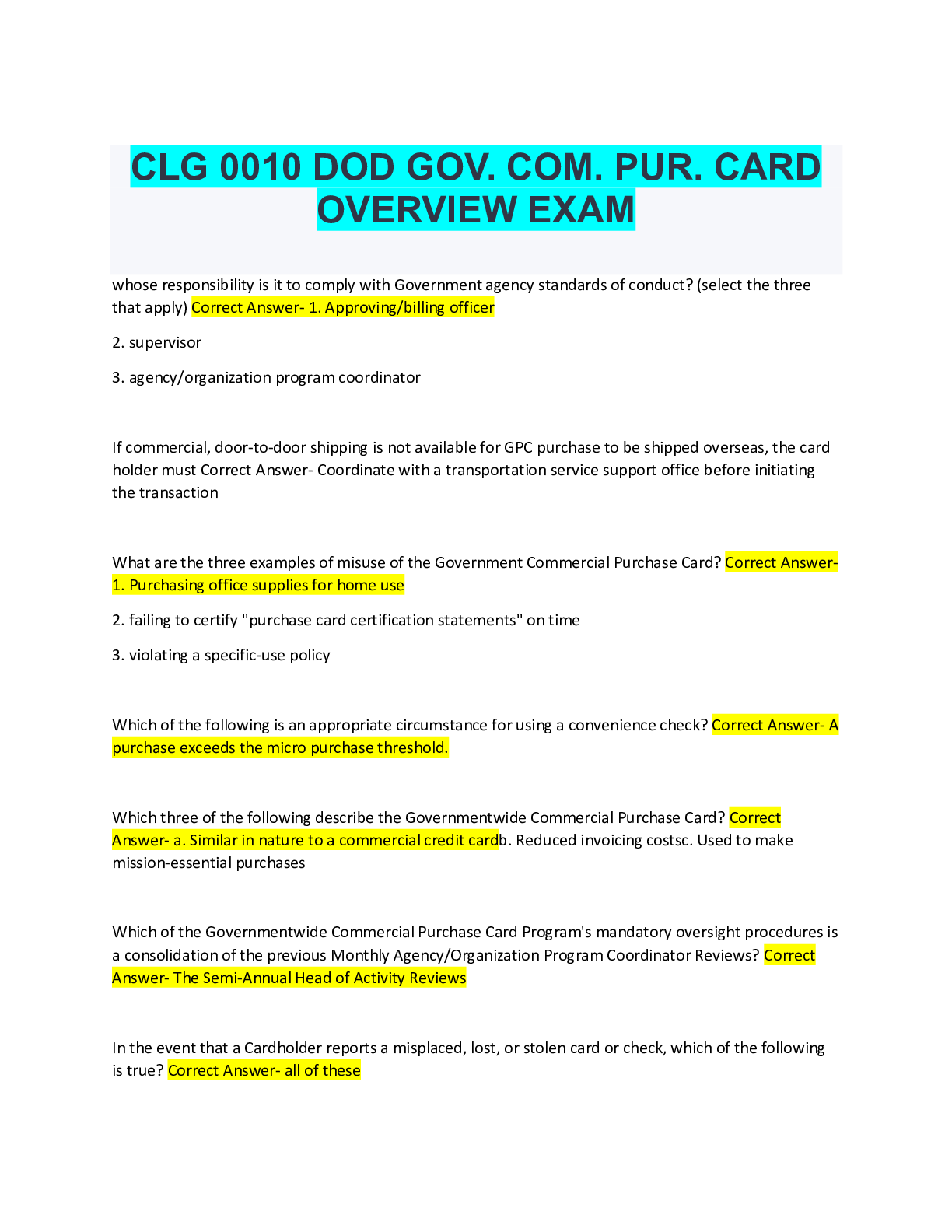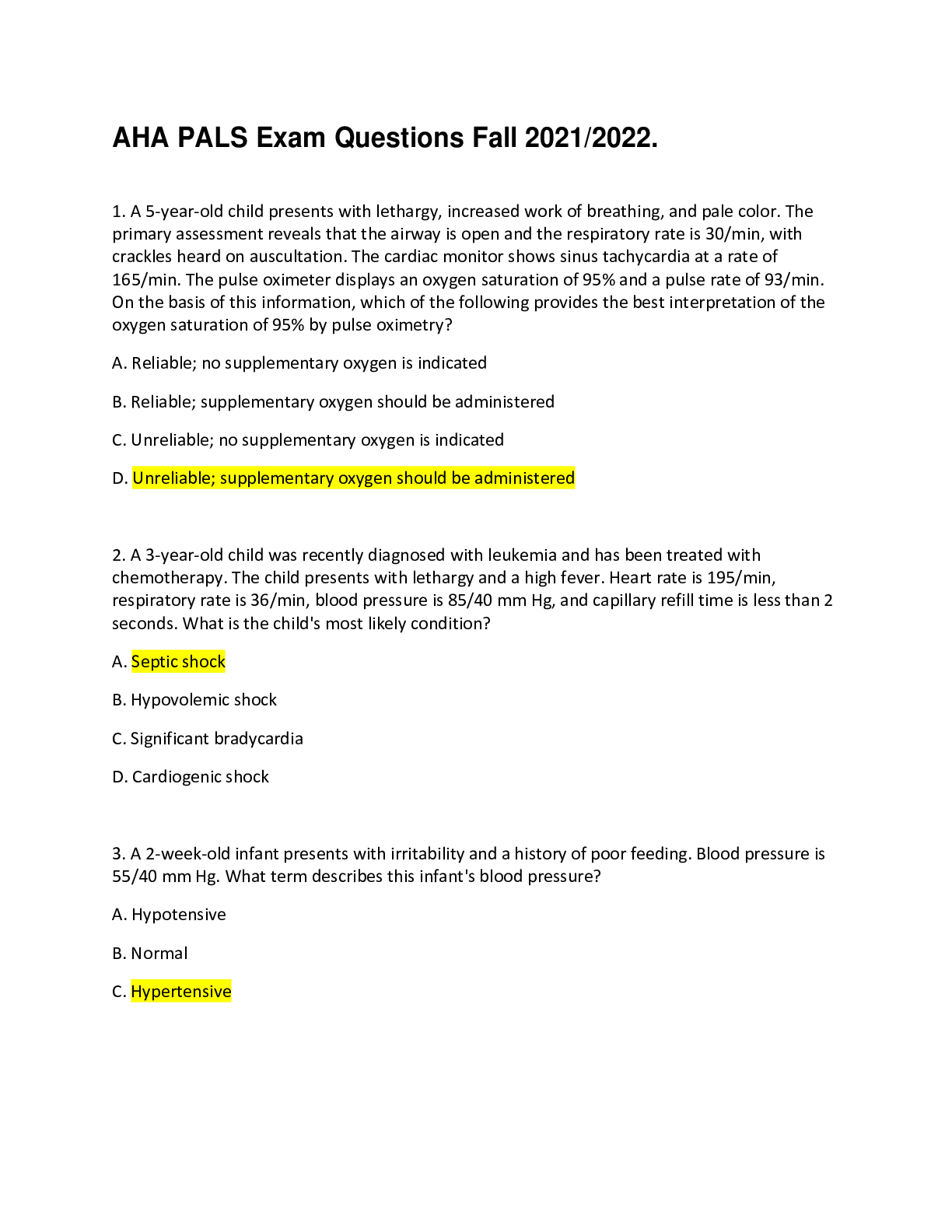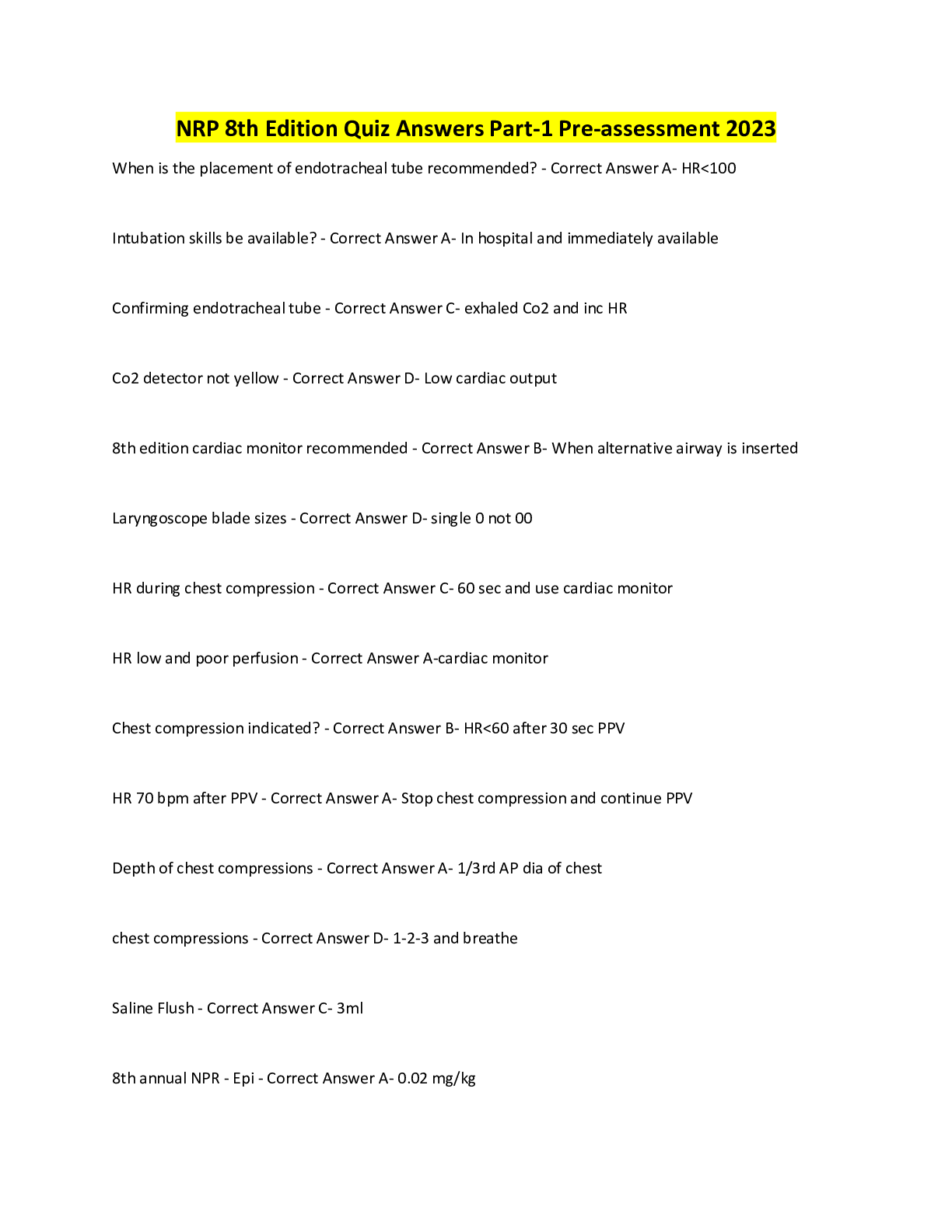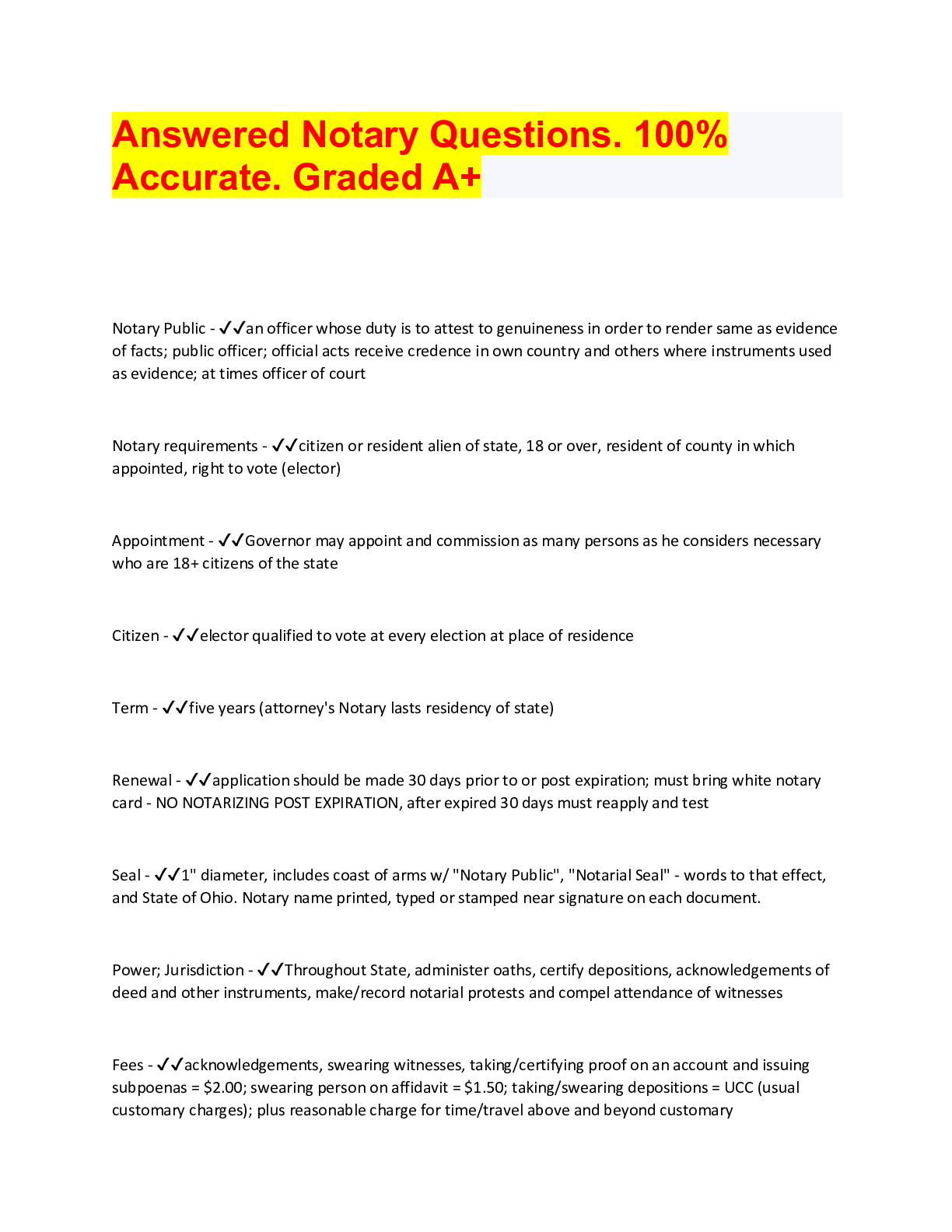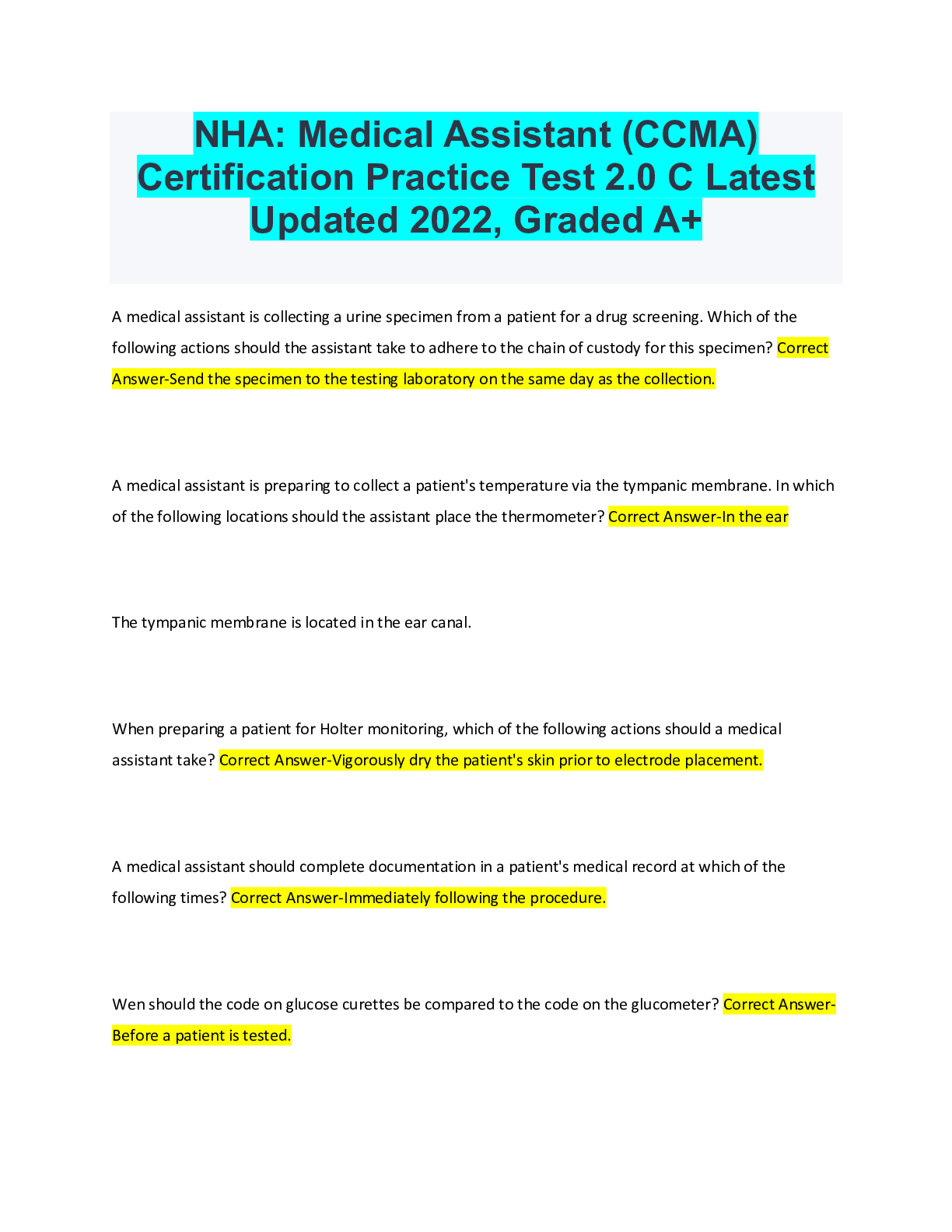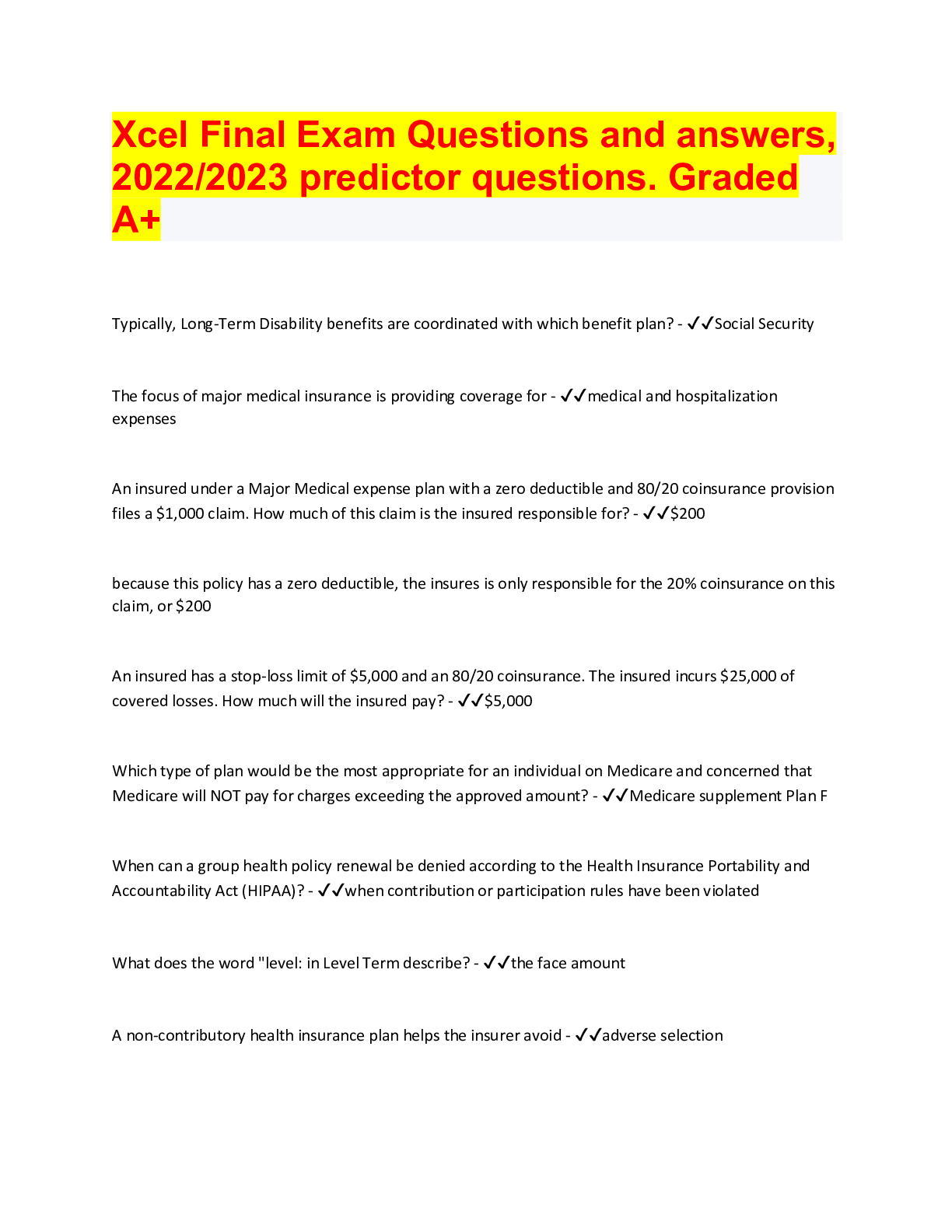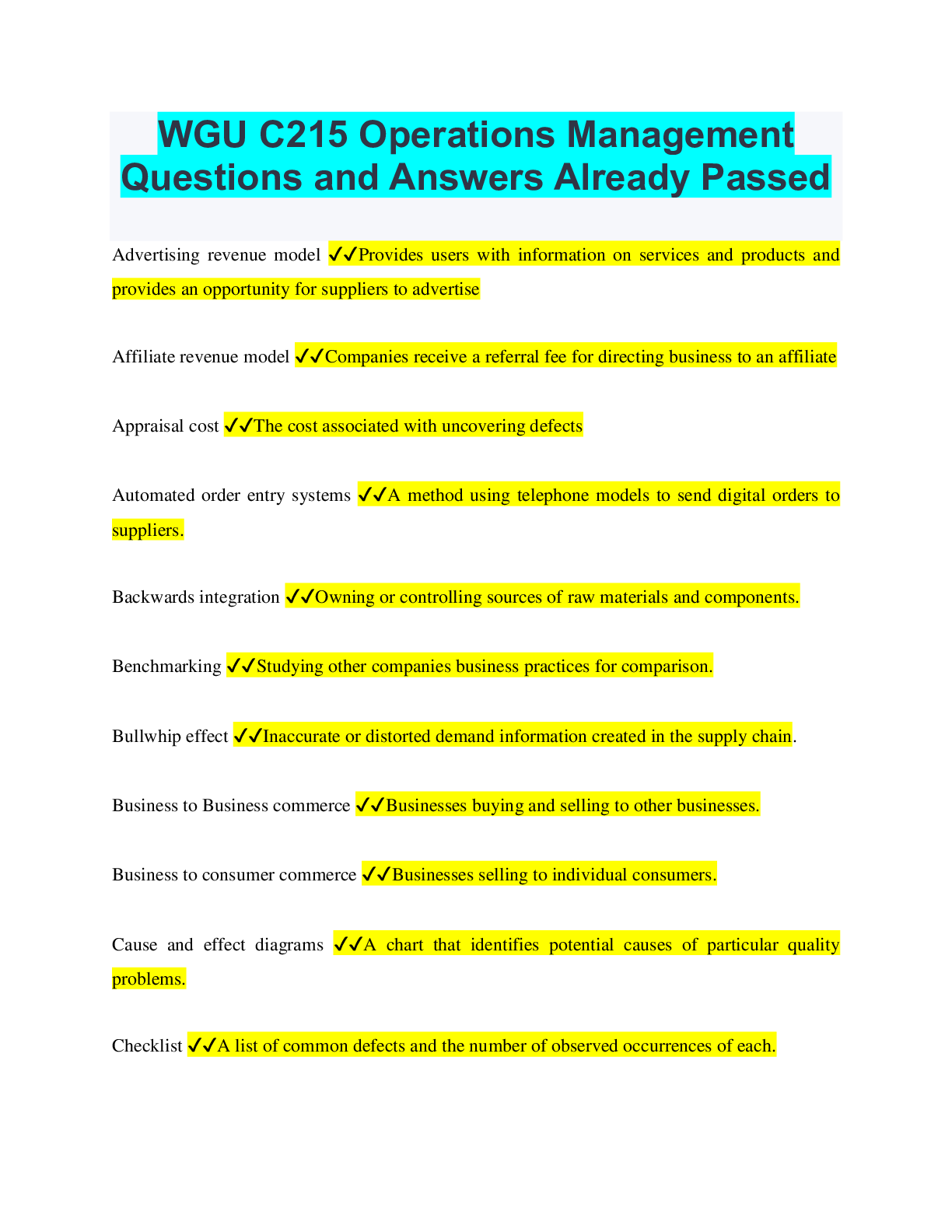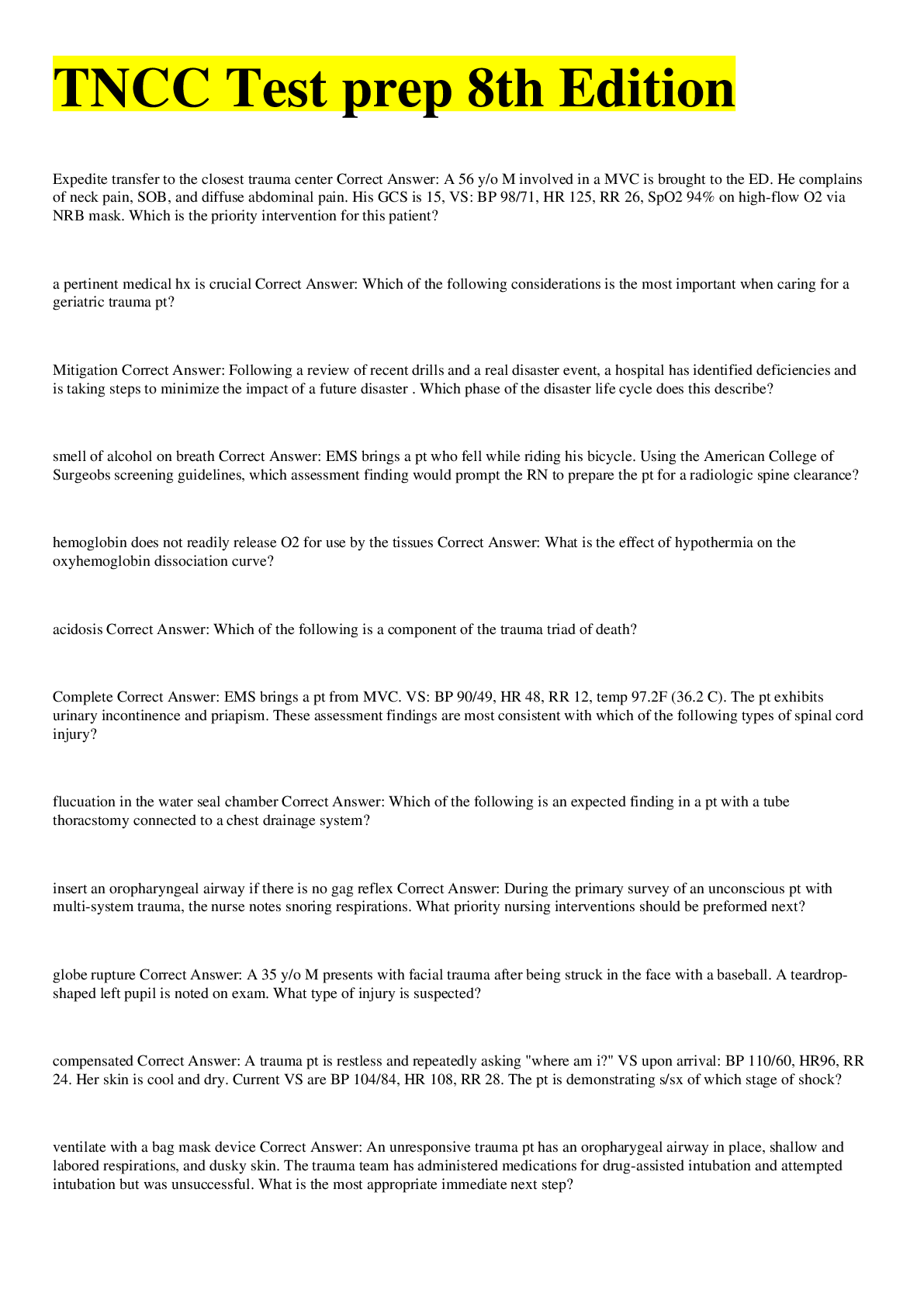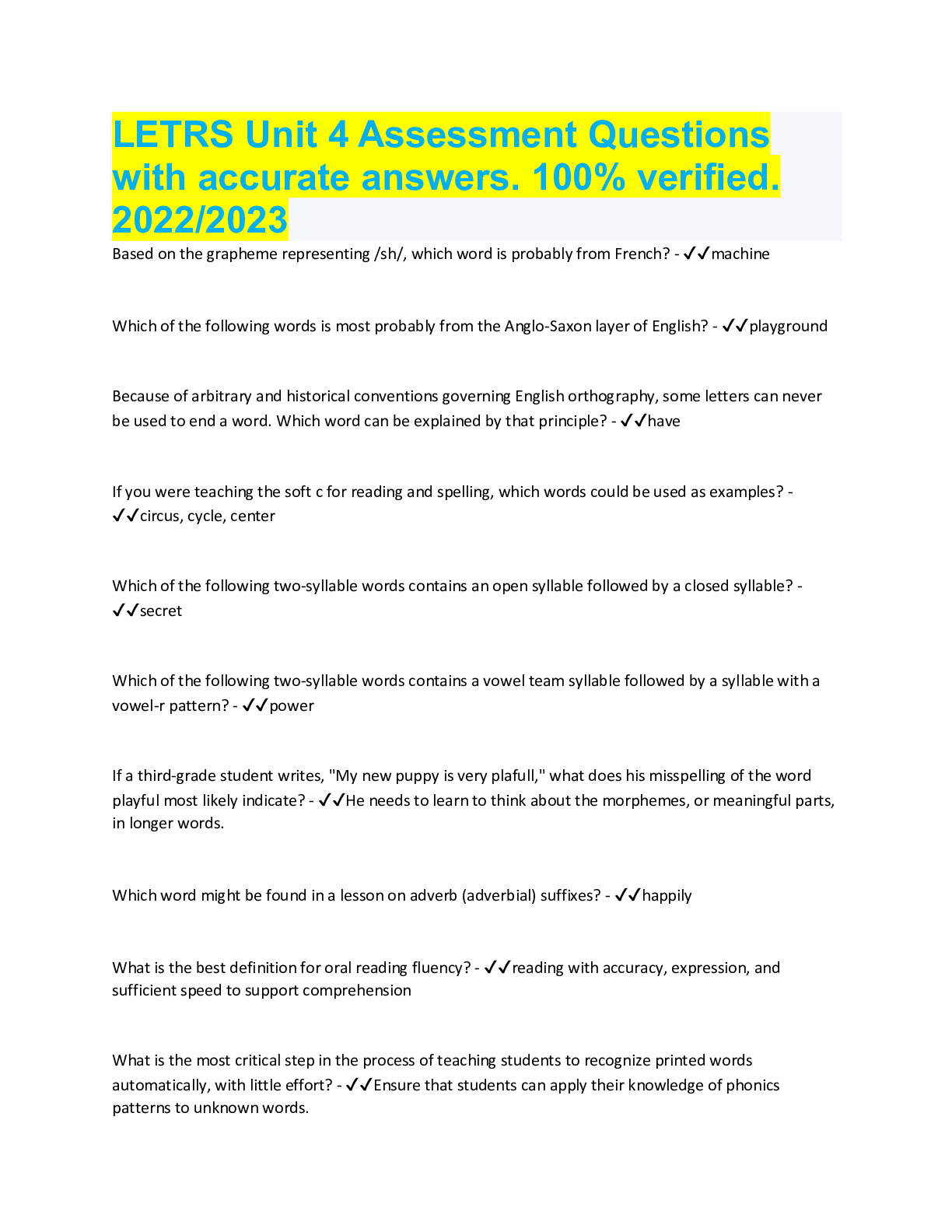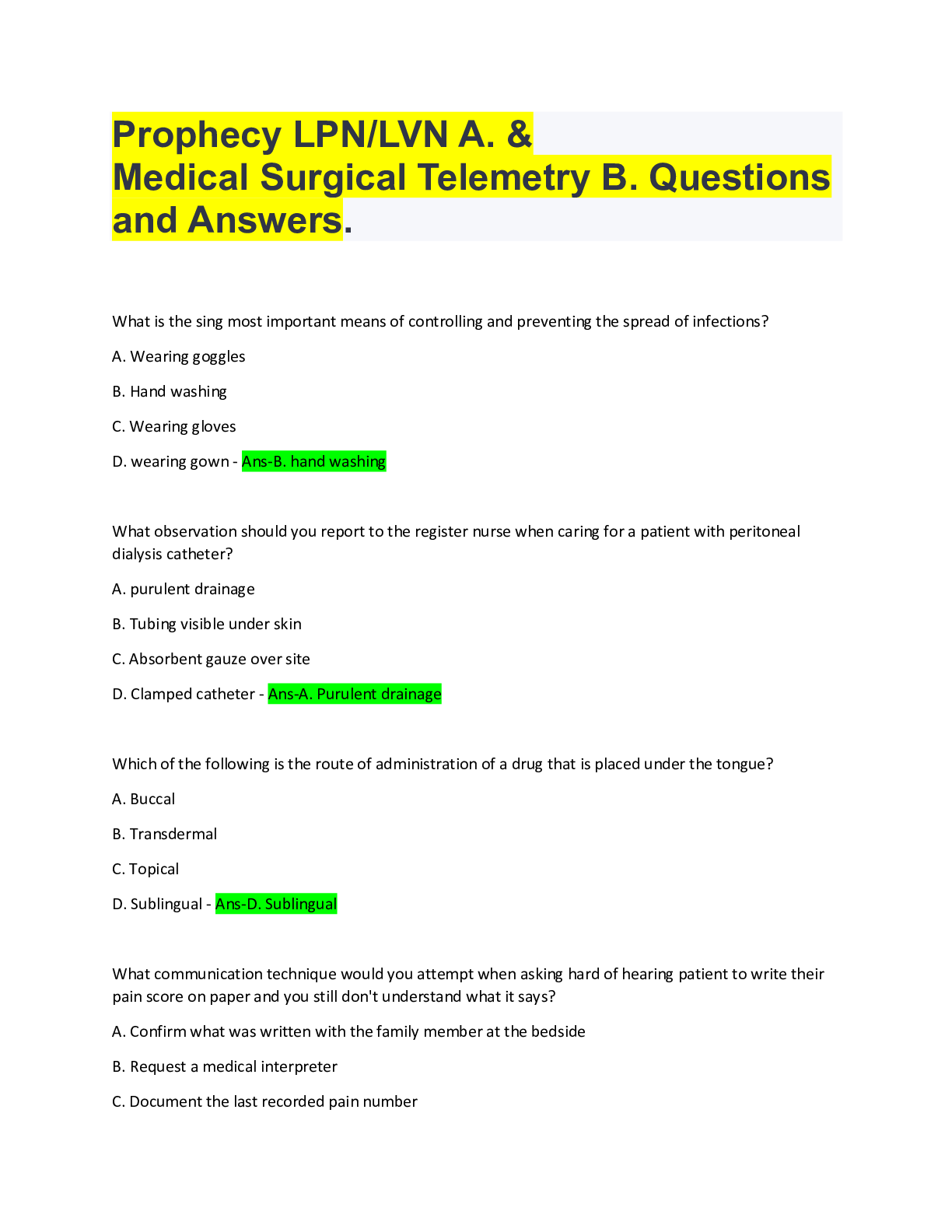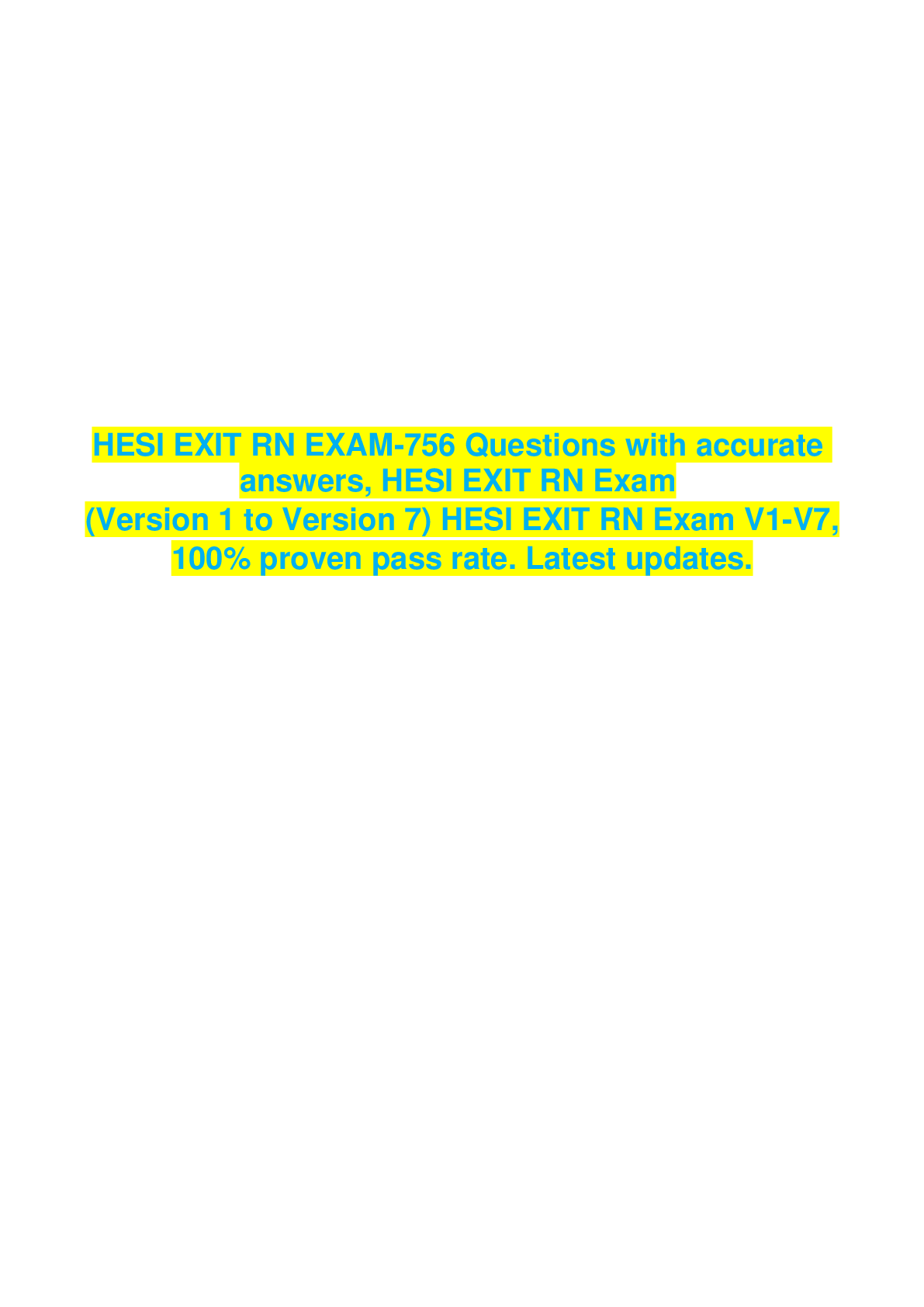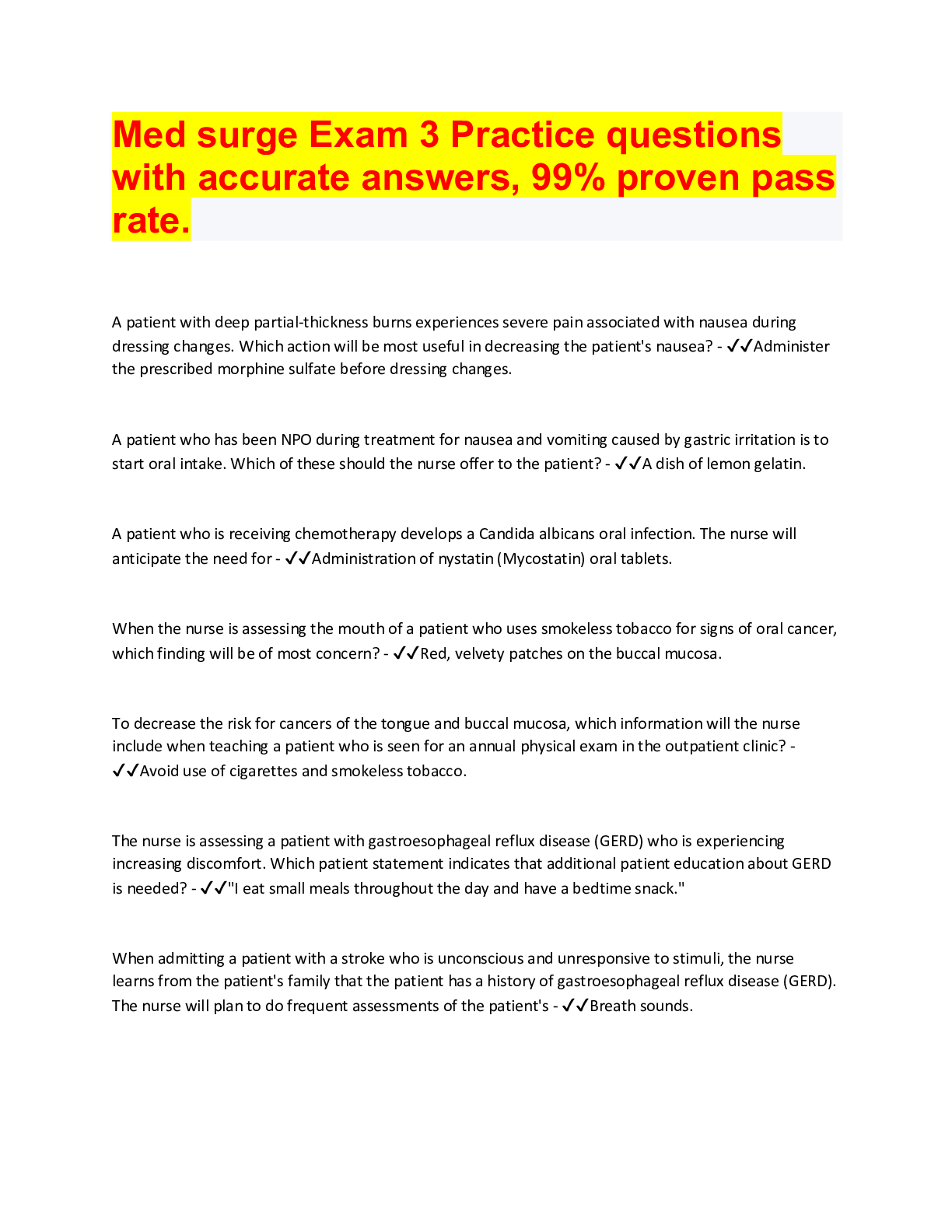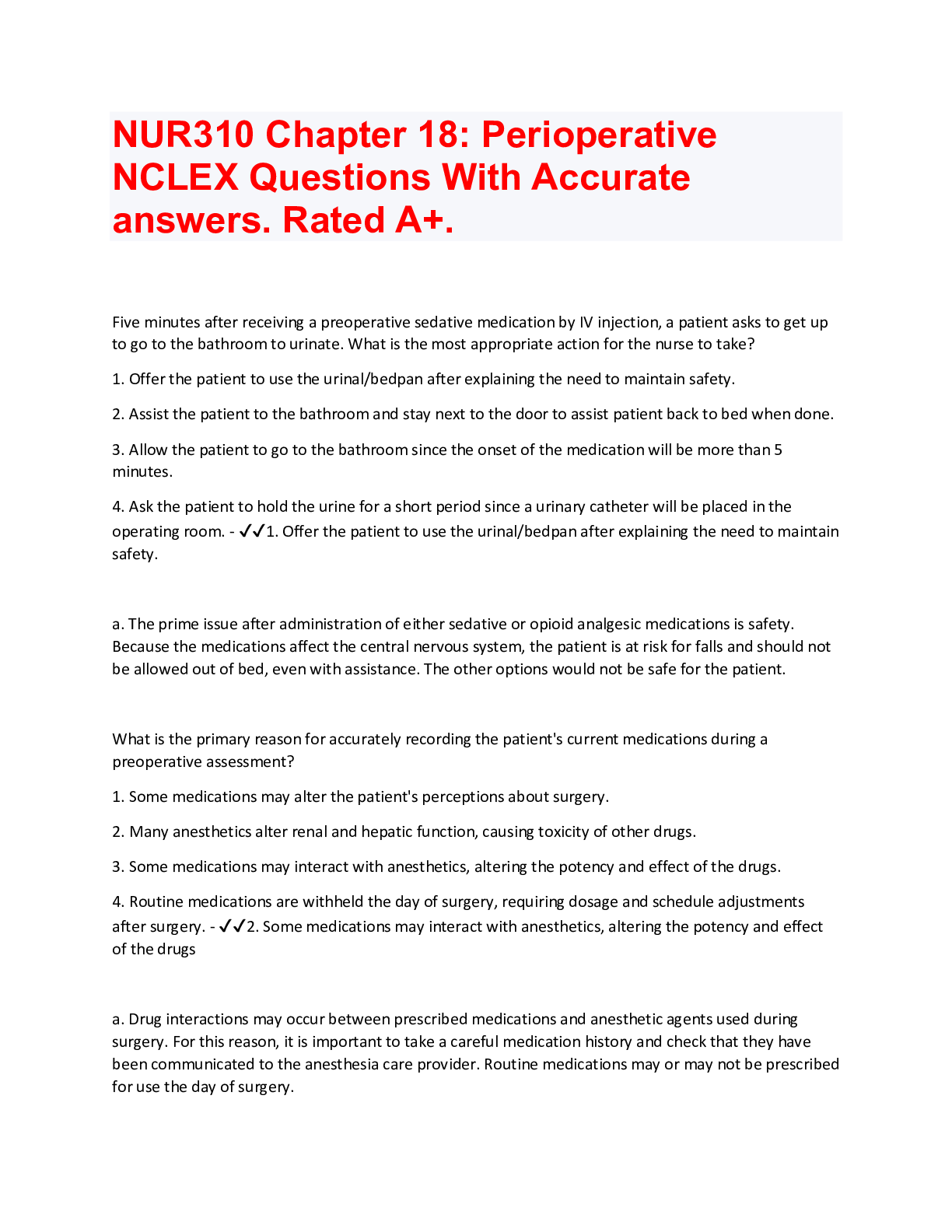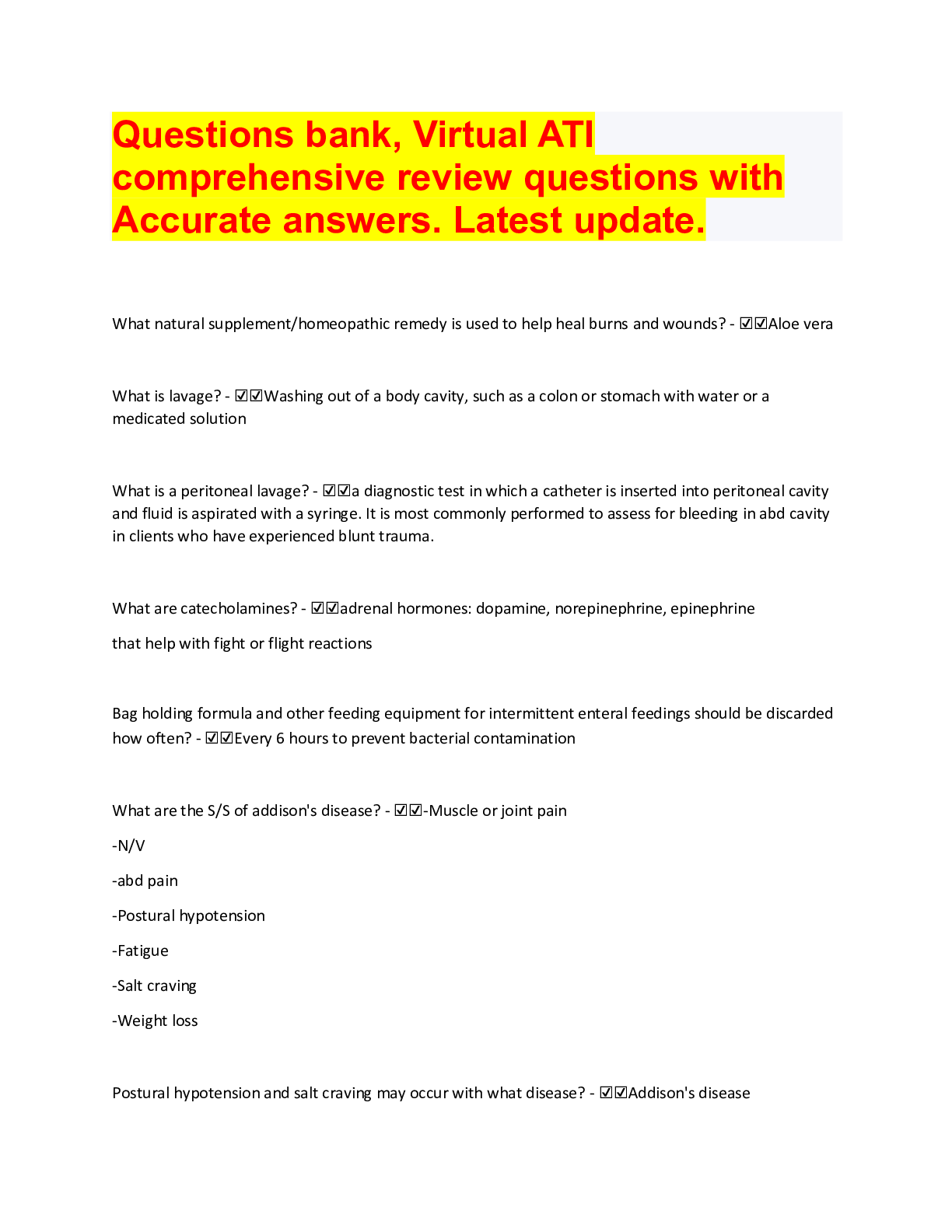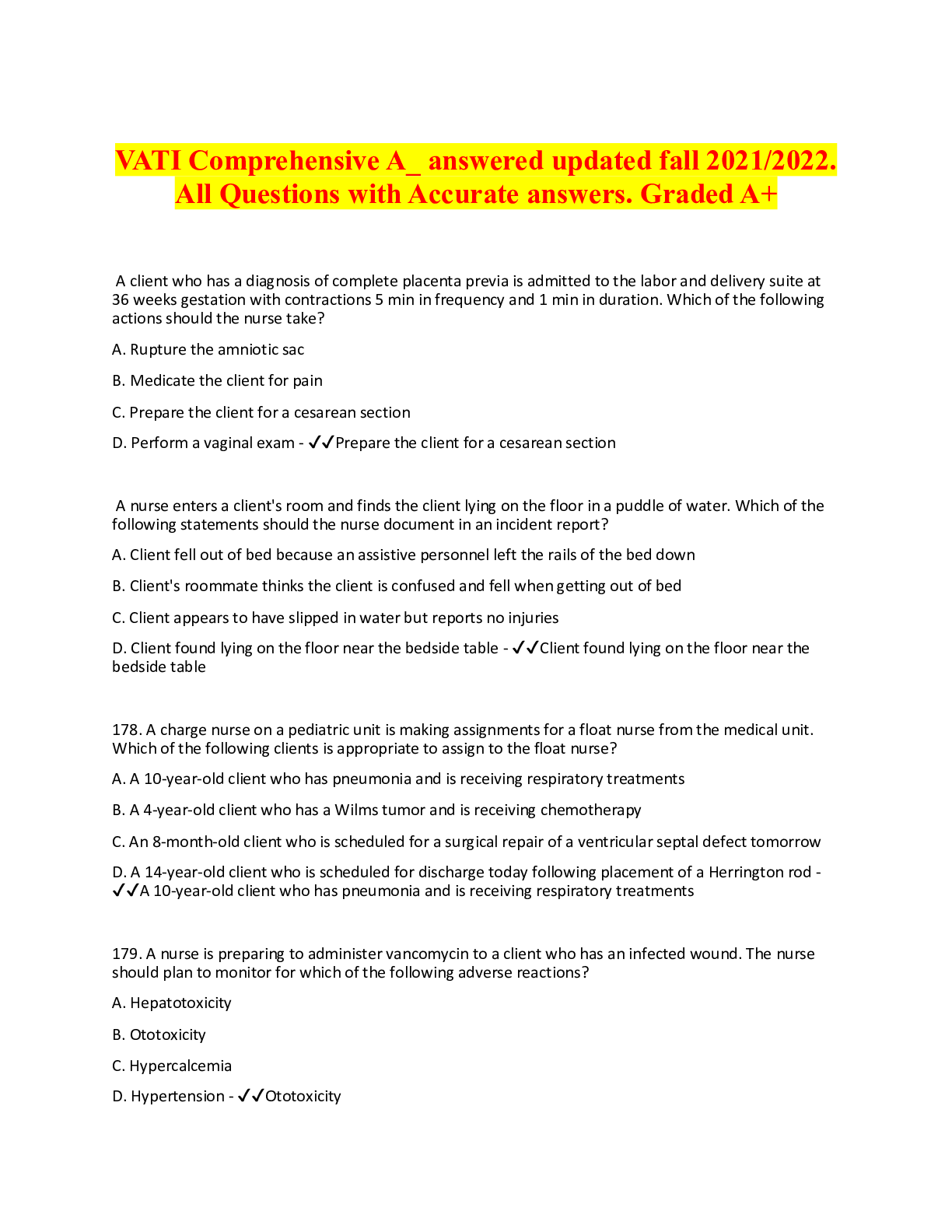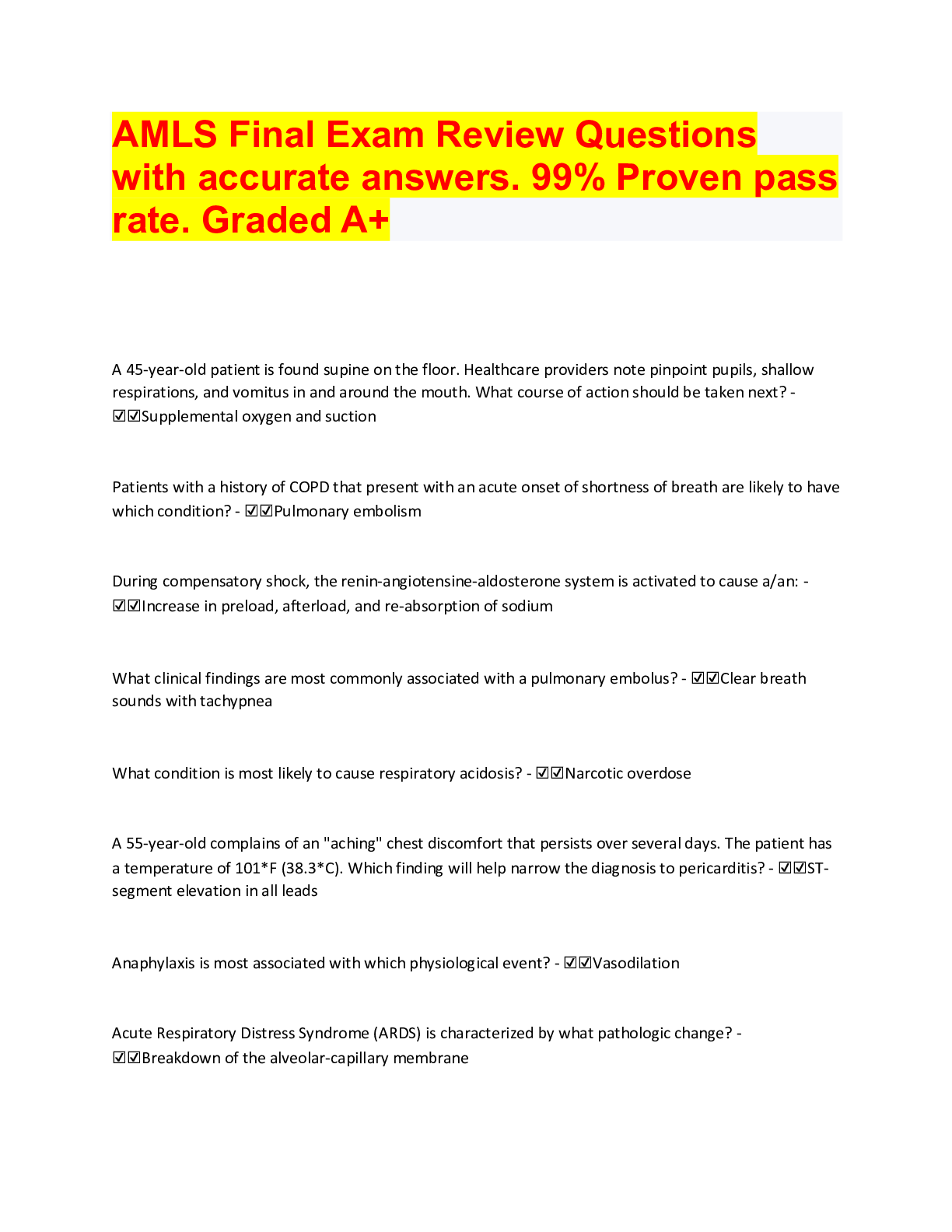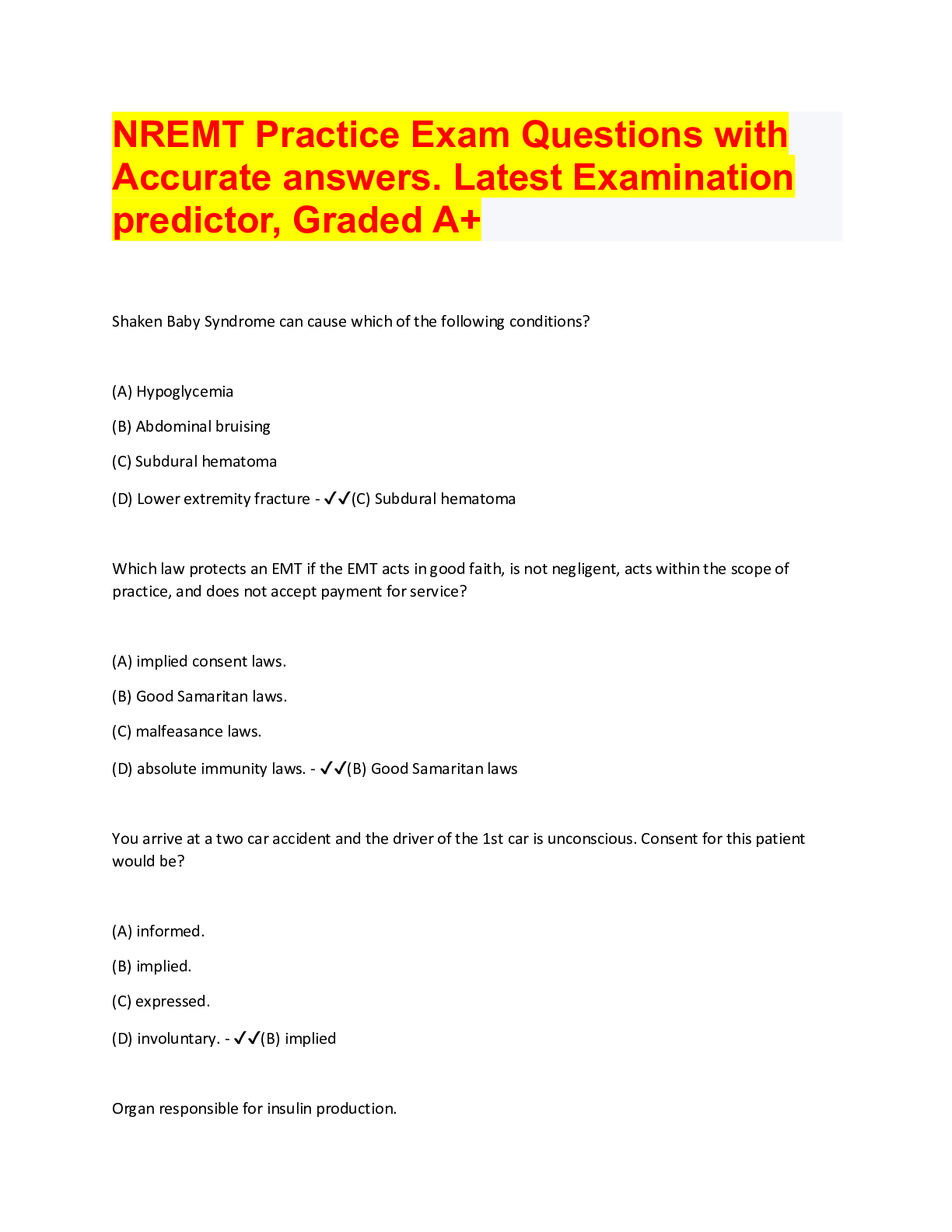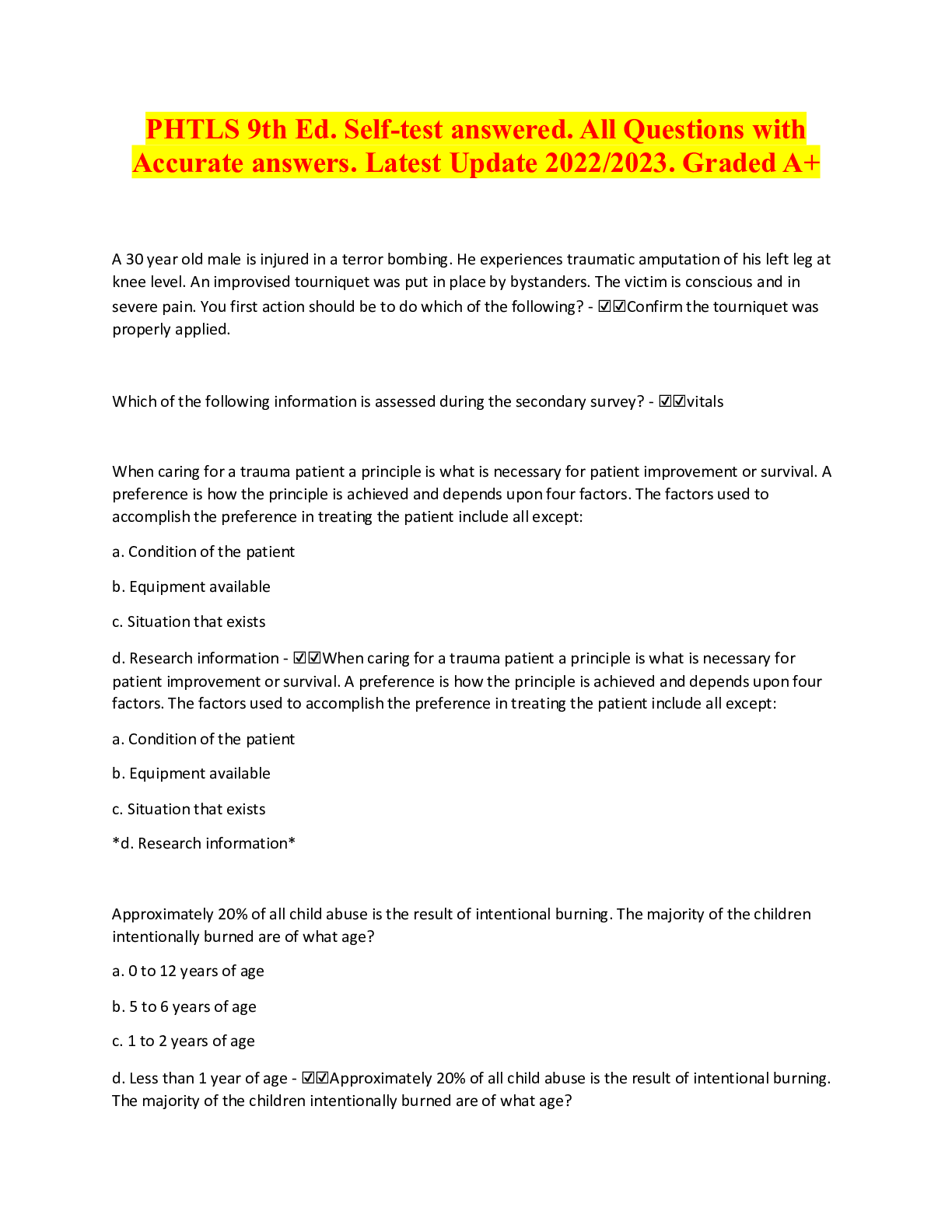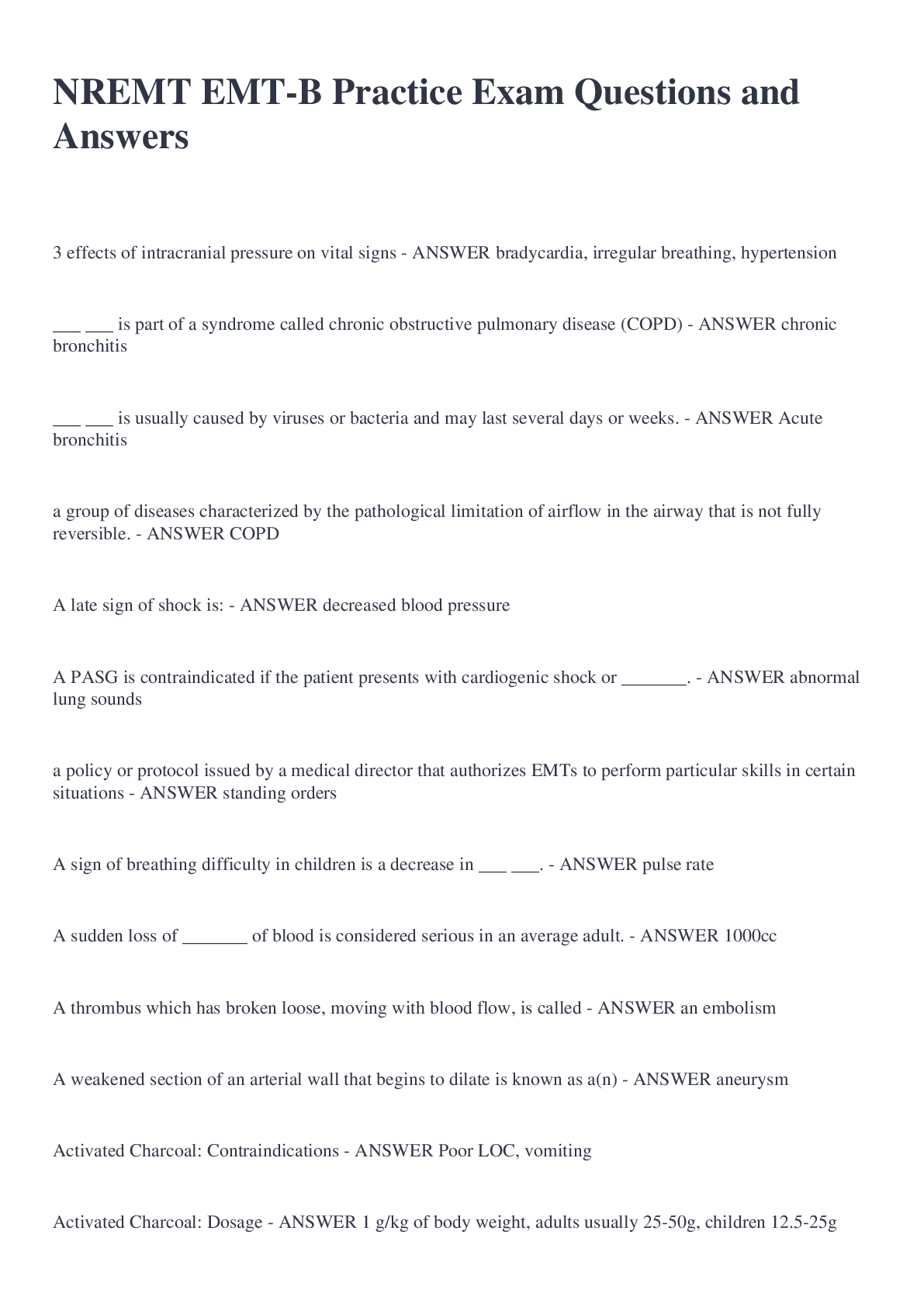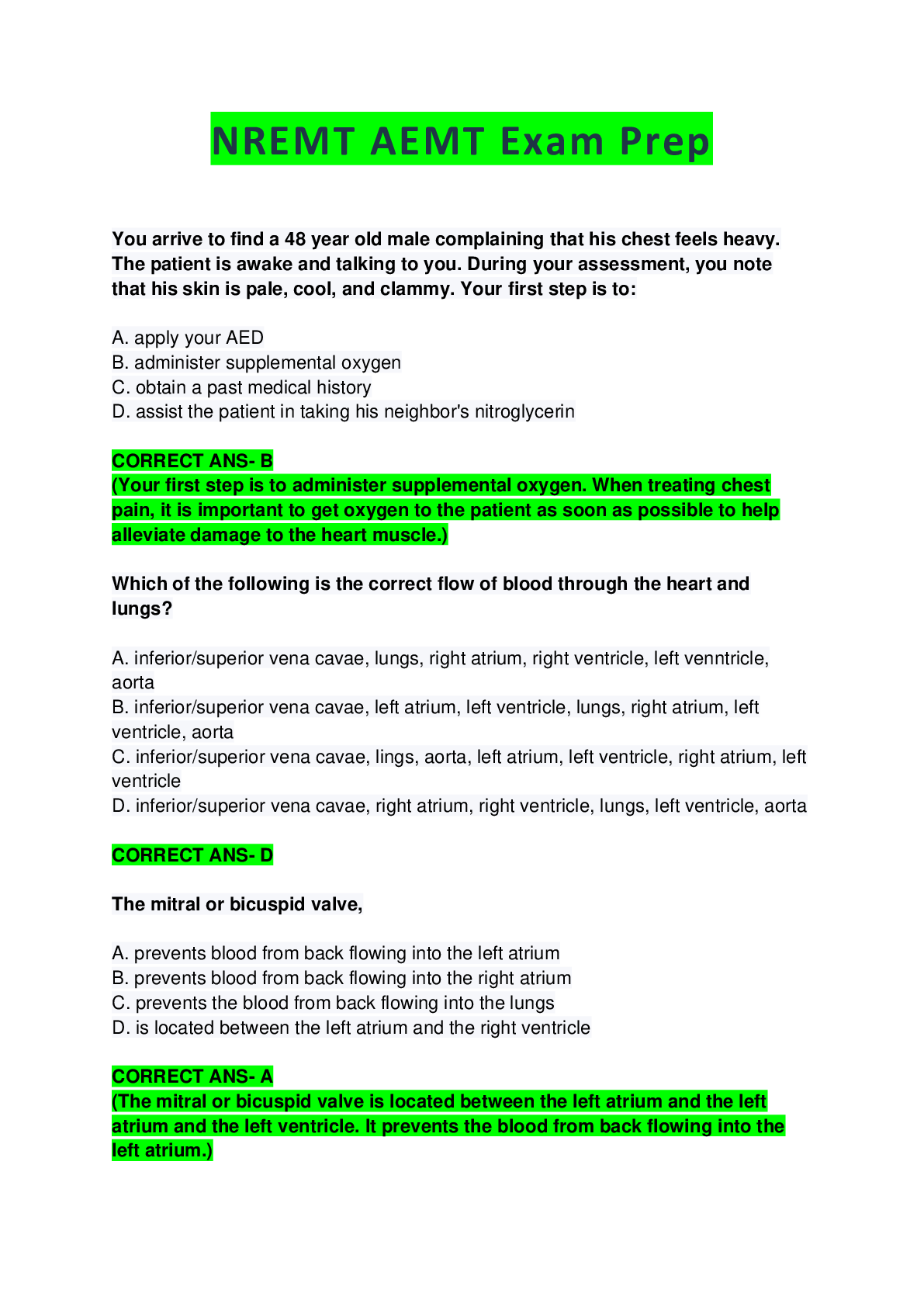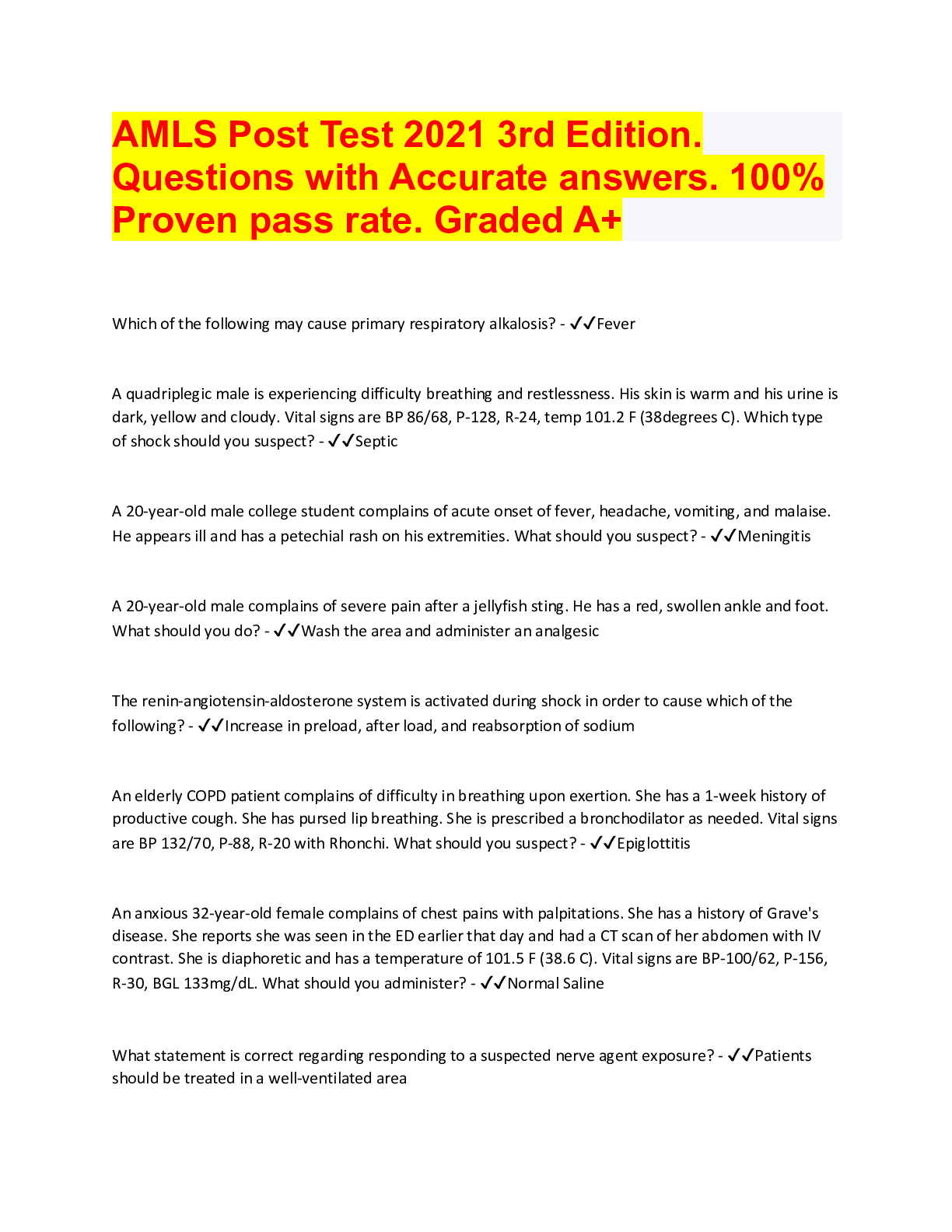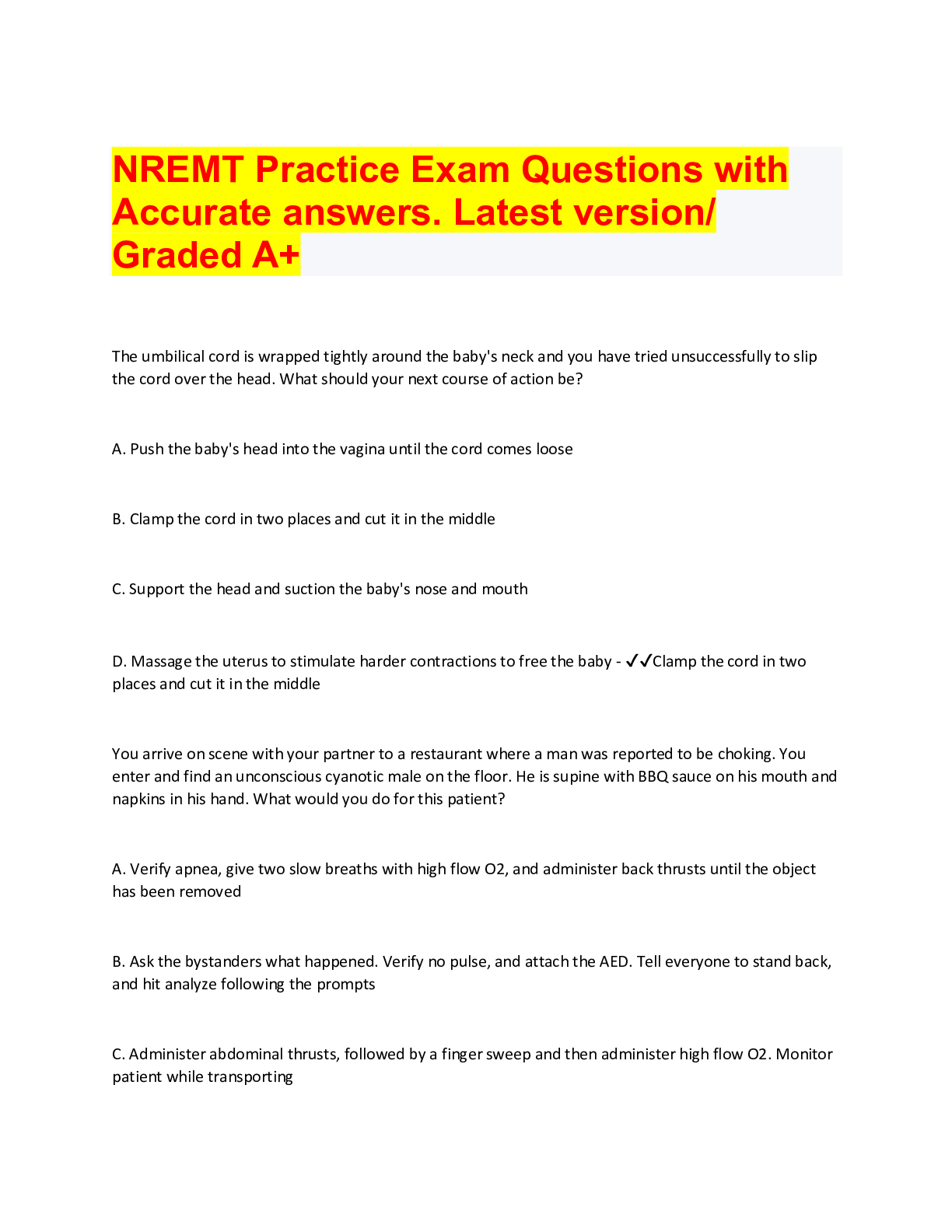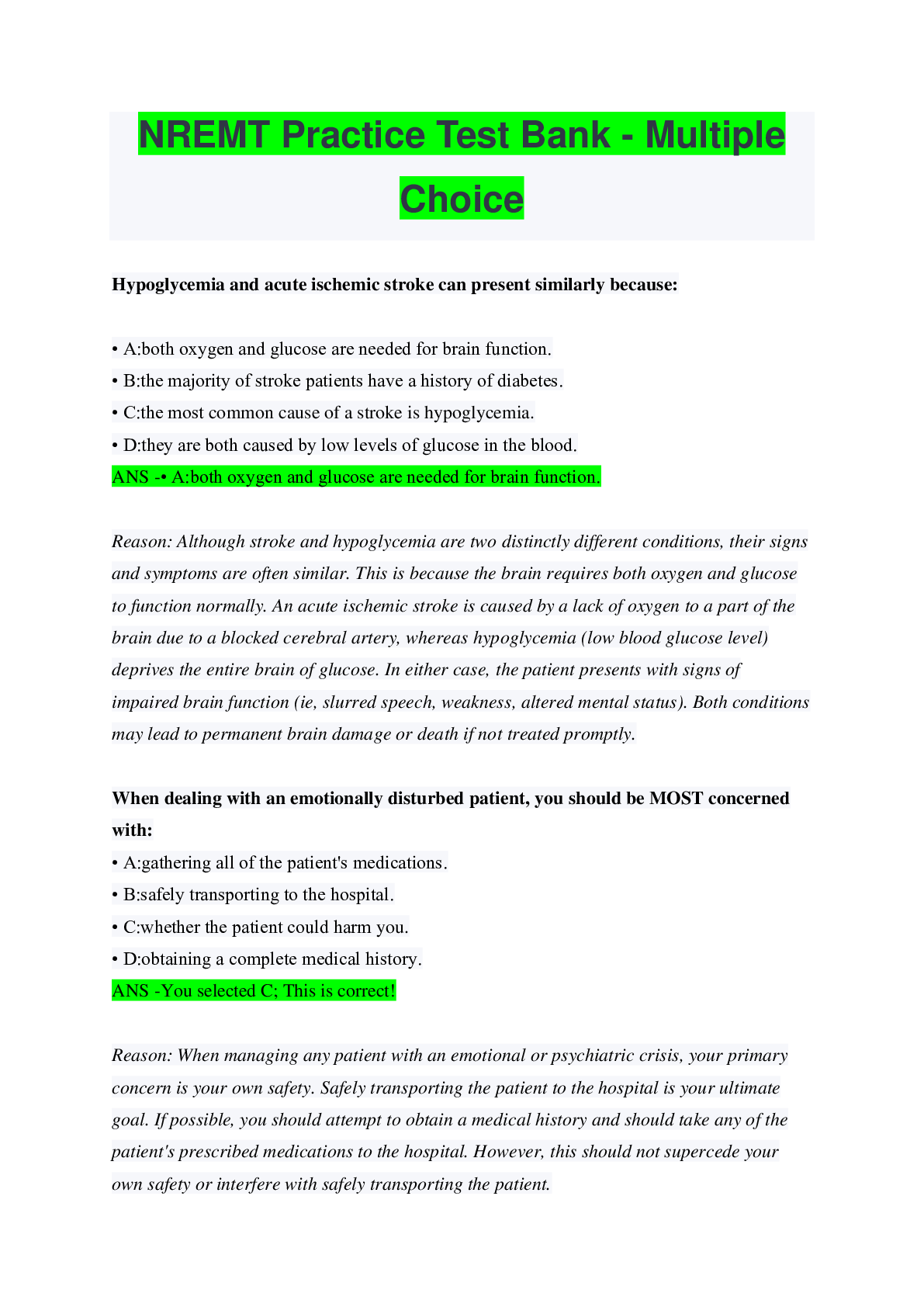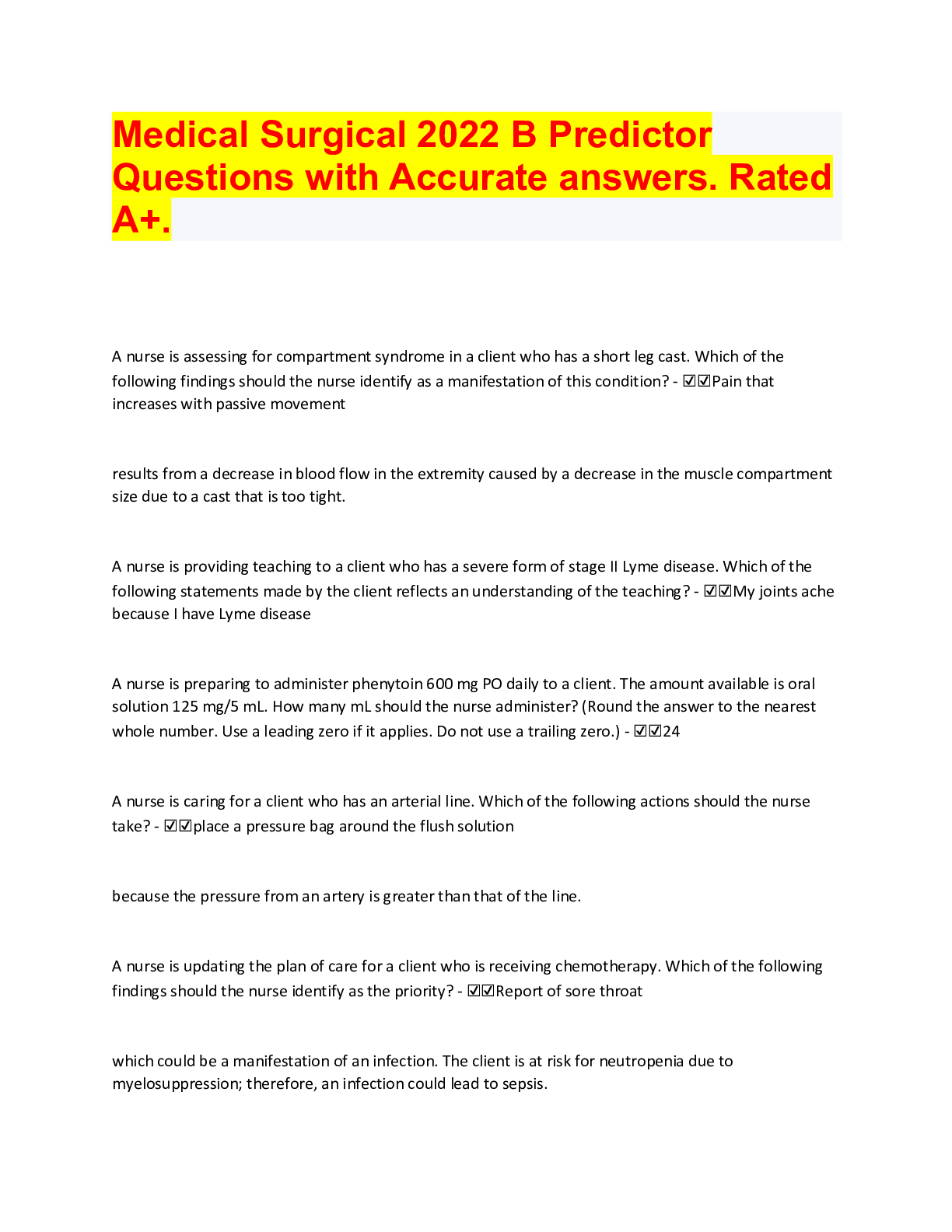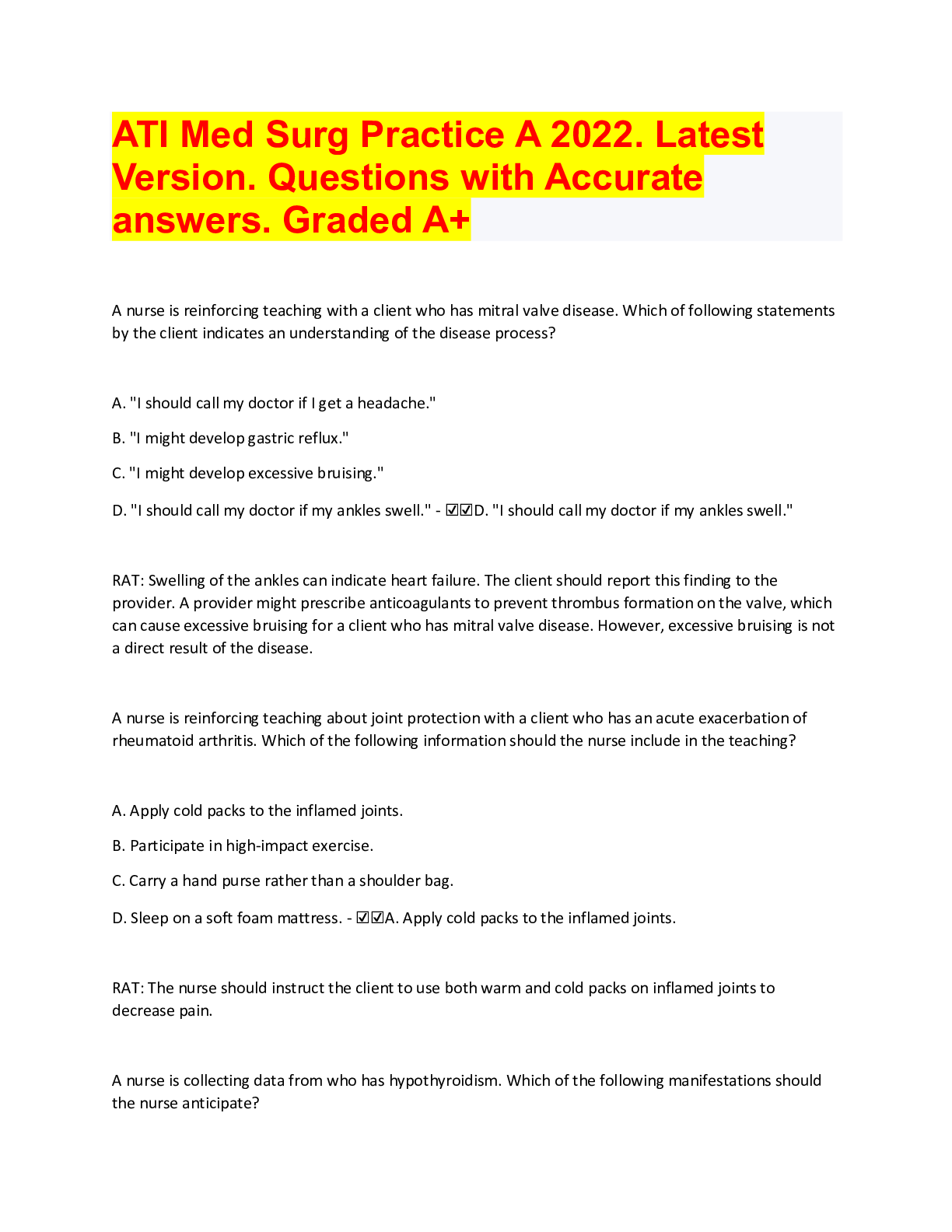*NURSING > QUESTIONS & ANSWERS > Test Bank Medical Surgical Nursing 9th Edition Ignatavicius Workman All Questions with accurate ans (All)
Test Bank Medical Surgical Nursing 9th Edition Ignatavicius Workman All Questions with accurate answers, latest update.Test Bank Ignatavicius Medical Surgical 9th edition Medical-Surgical Nursing (Miami Dade College)
Document Content and Description Below
Test Bank Medical Surgical Nursing 9th Edition Ignatavicius Workman All Questions with accurate answers, latest update Test Bank Ignatavicius Medical Surgical 9th edition Medical-Sur... gical Nursing (Miami Dade College) Test Bank - Medical-Surgical Nursing: Concepts for Interprofessional Collaborative Care 9e 1 Table of Contents Table of Contents 1 Chapter 01: Overview of Professional Nursing P Concepts for Medical-Surgical Nursing Chapter 02: a Overview of Health Concepts for Medical-Surgical t Nursing i Chapter 03: Common Health e Problems of Older Adults n Chapter 04: Assessment and t Care of Patients with Pain s Chapter 05: Genetic Concepts for Medical- w Surgical Nursing Chapter 06: Rehabilitation Concepts for Chronic i t and Disabling Health Problems Chapter 07: End- h of-Life Care Chapter 08: Concepts of Emergency and Trauma I Nursing Chapter 09: Care of Patients with n f Common Environmental Emergencies e Chapter 10: Concepts of Emergency and Disaster Preparedness Chapter 11: Assessment and Care of Patients with c t i Fluid and Electrolyte Imbalances Chapter 12: o Assessment and Care of Patients with Acid-Base n Imbalances Chapter 13: Infusion Therapy C h Chapter 14: a Care of Preoperative Patients Chapter 15: p t e r Care of Intraoperativ 2 e Patients 4 Chapter 16: : Care of Postoperativ A e Patients s Chapter 17: s Inflammation e and s Immunity s Chapter 18: Care of Patients with Arthritis and m Other Connective Tissue Diseases Chapter 19: e Care of Patients with HIV Disease n Chapter 20: Care of Patients with t Hypersensitivity (Allergy) and Autoimmunity Chapter 21: Cancer Development o Chapter 22: f Care of Patients t with Cancer h Chapter 23: e Care of Stuvia.com - The Marketplace to Buy and Sell your Study Material Test Bank - Medical-Surgical Nursing: Concepts for Interprofessional Collaborative Care 9e 2 S ki k n i Pr n o , bl e H m a s i C r h , a pt a er n 2 d 6: C N ar a e i of l P s at ie C nt h s a wi p th t B e ur r n s 2 5 : C a r e o f P a t i e n t s w i t h S Chapter 27: Assessment of the Respiratory System 3 Chapter 28: Care of Patients Requiring 8 Oxygen Therapy or Tracheostomy Chapter 29: 13 Care of Patients with Noninfectious Upper 20 Respiratory Problems Chapter 30: Care of 32 Patients with Noninfectious Lower Respiratory 38 Problems Chapter 31: Care of Patients with 44 Infectious Respiratory Problems 50 Chapter 32: Care of Critically Ill 56 Patients with Respiratory Problems 62 Chapter 33: Assessment of the 68 Cardiovascular System 76 Chapter 34: Care of 83 Patients with 94 Dysrhythmias Chapter 10 35: Care of Patients 3 with Cardiac Problems 10 Chapter 36: Care of 9 Patients with Vascular 11 Problems Chapter 37: 6 Care of Patients with 12 Shock 2 Chapter 38: Care of Patients 13 with Acute Coronary 8 Syndromes Chapter 39: 14 Assessment of the Hematologic 7 System 15 Chapter 40: Care of 2 Patients with Hematologic 15 Problems Chapter 41: 7 Assessment of the 16 Nervous System 7 Chapter 42: Care of Patients with 17 Problems of the CNS: The Brain Chapter 4 43: Care of Patients with Problems of the 17 CNS: The Spinal Cord 9 Chapter 44: Care of Patients with Problems of 19 the Peripheral Nervous System Chapter 45: 6 Care of Critically Ill Patients with Neurologic 21 Problems 3 Chapter 46: Assessment of the Eye and Vision 22 Chapter 47: Care of Patients with Eye and Vision 0 Problems 22 Chapter 48: Assessment and Care of Patients 6 with Ear and Hearing Problems Chapter 49: 23 Assessment of the Musculoskeletal System 3 Chapter 50: Care of Patients with Musculoskeletal 24 Problems 5 25 6 26 9 27 8 28 7 3 298 310 317 327 331 343 353 364 374 380 394 h a p t e r 5 1 : C a r e o f P a t i e n t s w i t h M u s c u l o s k 3 9 7 4 0 3 4 1 0 4 1 5 el et al Tr a u m a C h a pt er 5 2: A ss es s m e nt of th e G as tr oi nt es tin al S ys te m C h a pt er 53: Care of Patients with 4 Oral Cavity Problems 2 Chapter 54: Care of Patients 4 with Esophageal Problems 4 Chapter 55: Care of Patients 3 with Stomach Disorders 5 Chapter 56: Care of Patients with 4 Noninflammatory Intestinal Disorders 4 Chapter 57: Care of Patients with 1 Inflammatory Intestinal Disorders Chapter 4 58: Care of Patients with Liver Problems 4 Chapter 59: Care of Patients with Problems of the 5 Biliary System and Pancreas Chapter 60: Care of 4 5 Patients with Malnutrition: Undernutrition and 4 Obesity Chapter 61: Assessment of the Endocrine 4 System 6 Chapter 62: Care of Patients with Pituitary and 1 Adrenal Gland Problems 4 Chapter 63: Care of Patients with Problems of the 7 Thyroid and Parathyroid Glands Chapter 64: Care of 1 Patients with Diabetes Mellitus 4 Chapter 65: Assessment of 8 the Renal/Urinary System 1 Chapter 66: Care of Patients 4 with Urinary Problems 8 Chapter 67: Care of Patients 9 with Kidney Disorders 4 Chapter 68: Care of Patients with Acute Kidney 9 Injury and Chronic Kidney Disease Chapter 69: 5 Assessment of the Reproductive System 0 Chapter 70: Care of 6 Patients with Breast 5 Disorders Chapter 71: 1 Care of Patients with 2 Gynecologic Problems 5 Chapter 72: Care of Patients with 2 Male Reproductive Problems 0 Chapter 73: Care of Transgender 5 Patients 2 Chapter 74: Care of Patients with Sexually 7 Transmitted Diseases 5 4 9 5 5 7 5 6 8 5 7 5 5 8 7 Stuvia.com - The Marketplace to Buy and Sell your Study Material Test Bank - Medical-Surgical Nursing: Concepts for Interprofessional Collaborative Care 9e 4 591 6 598 1 605 8 614 Chapter 01: Overview of Professional Nursing Concepts for Medical- Surgical Nursing MULTIPLE CHOICE 1. A nurse wishes to provide client-centered care in all interactions. Which action by the nurse best demonstrates this concept? a. Assesses for cultural influences affecting health care b. Ensures that all the clients basic needs are met c. Tells the client and family about all upcoming tests d. Thoroughly orients the client and family to the room ANS: A Competency in client-focused care is demonstrated when the nurse focuses on communication, culture, respect compassion, client education, and empowerment. By assessing the effect of the clients culture on health care, this nurse is practicing client-focused care. Providing for basic needs does not demonstrate this competence. Simply telling the client about all upcoming tests is not providing empowering education. Orienting the client and family to the room is an important safety measure, but not directly related to demonstrating client-centered care. DIF: Understanding/Comprehension REF: 3 KEY: Patient-centered care| culture MSC: Integrated Process: Caring NOT: Client Needs Category: Psychosocial Integrity 2. A nurse is caring for a postoperative client on the surgical unit. The clients blood pressure was 142/76 mm Hg 30 minutes ago, and now is 88/50 mm Hg. What action by the nurse is best? a. Call the Rapid Response Team. b. Document and continue to monitor. c. Notify the primary care provider. d. Repeat blood pressure measurement in 15 minutes. ANS: A The purpose of the Rapid Response Team (RRT) is to intervene when clients are deteriorating before they suffer either respiratory or cardiac arrest. Since the client has manifested a significant change, the nurse should call the RRT. Changes in blood pressure, mental status, heart rate, and pain are particularly significant. Documentation is vital, but the nurse must do more than document. The primary care provider should be notified, but this is not the priority over calling the RRT. The clients blood pressure should be reassessed frequently, but the priority is getting the rapid care to the client. DIF: Applying/Application REF: 3 KEY: Rapid Response Team (RRT)| medical emergencies MSC: Integrated Process: Communication and Documentation NOT: Client Needs Category: Physiological Integrity: Physiological Adaptation 3. A nurse is orienting a new client and family to the inpatient unit. What information does the nurse provide to help the client promote his or her own safety? a. Encourage the client and family to be active partners. b. Have the client monitor hand hygiene in caregivers. c. Offer the family the opportunity to stay with the client. d. Tell the client to always wear his or her armband. ANS: A Each action could be important for the client or family to perform. However, encouraging the client to be active in his or her health care as a partner is the most critical. The other actions are very limited in scope and do not provide the broad protection that being active and involved does. DIF: Understanding/Comprehension REF: 3 KEY: Patient safety MSC: Integrated Process: Teaching/Learning NOT: Client Needs Category: Safe and Effective Care Environment: Safety and Infection Control 4. A new nurse is working with a preceptor on an inpatient medical-surgical unit. The preceptor advises the student that which is the priority when working as a professional nurse? a. Attending to holistic client needs b. Ensuring client safety c. Not making medication errors d. Providing client-focused care ANS: B All actions are appropriate for the professional nurse. However, ensuring client safety is the priority. Up to 98,000 deaths result each year from errors in hospital care, according to the 2000 Institute of Medicine report. Many more clients have suffered injuries and less serious outcomes. Every nurse has the responsibility to guard the clients safety. DIF: Understanding/Comprehension REF: 2 KEY: Patient safety MSC: Integrated Process: Nursing Process: Intervention NOT: Client Needs Category: Safe and Effective Care Environment: Safety and Infection Control 5. A client is going to be admitted for a scheduled surgical procedure. Which action does the nurse explain is the most important thing the client can do to protect against errors? a. Bring a list of all medications and what they are for. b. Keep the doctors phone number by the telephone. c. Make sure all providers wash hands before entering the room. d. Write down the name of each caregiver who comes in the room. ANS: A Medication errors are the most common type of health care mistake. The Joint Commissions Speak Up campaign encourages clients to help ensure their safety. One recommendation is for clients to know all their medications and why they take them. This will help prevent medication errors. DIF: Applying/Application REF: 4 KEY: Speak Up campaign| patient safety MSC: Integrated Process: Teaching/Learning NOT: Client Needs Category: Safe and Effective Care Environment: Safety and Infection Control 6. Which action by the nurse working with a client best demonstrates respect for autonomy? a. Asks if the client has questions before signing a consent b. Gives the client accurate information when questioned c. Keeps the promises made to the client and family d. Treats the client fairly compared to other clients ANS: A Autonomy is self-determination. The client should make decisions regarding care. When the nurse obtains a signature on the consent form, assessing if the client still has questions is vital, because without full information the client cannot practice autonomy. Giving accurate information is practicing with veracity. Keeping promises is upholding fidelity. Treating the client fairly is providing social justice. DIF: Applying/Application REF: 4 KEY: Autonomy| ethical principles MSC: Integrated Process: Caring NOT: Client Needs Category: Safe and Effective Care Environment: Management of Care 7. A student nurse asks the faculty to explain best practices when communicating with a person from the lesbian, gay, bisexual, transgender, and queer/questioning (LGBTQ) community. What answer by the faculty is most accurate? a. Avoid embarrassing the client by asking questions. b. Dont make assumptions about their health needs. c. Most LGBTQ people do not want to share information. d. No differences exist in communicating with this population. ANS: B Many members of the LGBTQ community have faced discrimination from health care providers and may be reluctant to seek health care. The nurse should never make assumptions about the needs of members of this population. Rather, respectful questions are appropriate. If approached with sensitivity, the client with any health care need is more likely to answer honestly. DIF: Understanding/Comprehension REF: 4 KEY: LGBTQ| diversity MSC: Integrated Process: Teaching/Learning NOT: Client Needs Category: Psychosocial Integrity 8. A nurse is calling the on-call physician about a client who had a hysterectomy 2 days ago and has pain that is unrelieved by the prescribed narcotic pain medication. Which statement is part of the SBAR format for communication? a. A: I would like you to order a different pain medication. b. B: This client has allergies to morphine and codeine. c. R: Dr. Smith doesnt like nonsteroidal anti-inflammatory meds. d. S: This client had a vaginal hysterectomy 2 days ago. ANS: B SBAR is a recommended form of communication, and the acronym stands for Situation, Background, Assessment, and Recommendation. Appropriate background information includes allergies to medications the on- call physician might order. Situation describes what is happening right now that must be communicated; the clients surgery 2 days ago would be considered background. Assessment would include an analysis of the clients problem; asking for a different pain medication is a recommendation. Recommendation is a statement of what is needed or what outcome is desired; this information about the surgeons preference might be better placed in background. DIF: Applying/Application REF: 5 KEY: SBAR| communication MSC: Integrated Process: Communication and Documentation NOT: Client Needs Category: Safe and Effective Care Environment: Management of Care 9. A nurse working on a cardiac unit delegated taking vital signs to an experienced unlicensed assistive personnel (UAP). Four hours later, the nurse notes the clients blood pressure is much higher than previous readings, and the clients mental status has changed. What action by the nurse would most likely have prevented this negative outcome? a. Determining if the UAP knew how to take blood pressure b. Double-checking the UAP by taking another blood pressure c. Providing more appropriate supervision of the UAP d. Taking the blood pressure instead of delegating the task ANS: C Supervision is one of the five rights of delegation and includes directing, evaluating, and following up on delegated tasks. The nurse should either have asked the UAP about the vital signs or instructed the UAP to report them right away. An experienced UAP should know how to take vital signs and the nurse should not have to assess this at this point. Double-checking the work defeats the purpose of delegation. Vital signs are within the scope of practice for a UAP and are permissible to delegate. The only appropriate answer is that the nurse did not provide adequate instruction to the UAP. DIF: Applying/Application REF: 6 KEY: Supervision| delegation| unlicensed assistive personnel MSC: Integrated Process: Communication and Documentation NOT: Client Needs Category: Safe and Effective Care Environment: Management of Care 10. A nurse is talking with a client who is moving to a new state and needs to find a new doctor and hospital there. What advice by the nurse is best? a. Ask the hospitals there about standard nurse-client ratios. b. Choose the hospital that has the newest technology. c. Find a hospital that is accredited by The Joint Commission. d. Use a facility affiliated with a medical or nursing school. ANS: C Accreditation by The Joint Commission (TJC) or other accrediting body gives assurance that the facility has a focus on safety. Nurse-client ratios differ by unit type and change over time. New technology doesnt necessarily mean the hospital is safe. Affiliation with a health professions school has several advantages, but safety is most important. DIF: Understanding/Comprehension REF: 2 KEY: The Joint Commission (TJC)| accreditation MSC: Integrated Process: Communication and Documentation NOT: Client Needs Category: Safe and Effective Care Environment: Safety and Infection Control 11. A newly graduated nurse in the hospital states that, since she is so new, she cannot participate in quality improvement (QI) projects. What response by the precepting nurse is best? a. All staff nurses are required to participate in quality improvement here. b. Even being new, you can implement activities designed to improve care. c. Its easy to identify what indicators should be used to measure quality. d. You should ask to be assigned to the research and quality committee. ANS: B The preceptor should try to reassure the nurse that implementing QI measures is not out of line for a newly licensed nurse. Simply stating that all nurses are required to participate does not help the nurse understand how that is possible and is dismissive. Identifying indicators of quality is not an easy, quick process and would not be the best place to suggest a new nurse to start. Asking to be assigned to the QI committee does not give the nurse information about how to implement QI in daily practice. DIF: Applying/Application REF: 6 KEY: Quality improvement MSC: Integrated Process: Communication and Documentation NOT: Client Needs Category: Safe and Effective Care Environment: Management of Care MULTIPLE RESPONSE 1. A nurse is interested in making interdisciplinary work a high priority. Which actions by the nurse best demonstrate this skill? (Select all that apply.) a. Consults with other disciplines on client care b. Coordinates discharge planning for home safety c. Participates in comprehensive client rounding d. Routinely asks other disciplines about client progress e. Shows the nursing care plans to other disciplines ANS: A, B, C, D Collaborating with the interdisciplinary team involves planning, implementing, and evaluating client care as a team with all other disciplines included. Simply showing other caregivers the nursing care plan is not actively involving them or collaborating with them. DIF: Applying/Application REF: 4 KEY: Collaboration| interdisciplinary team MSC: Integrated Process: Communication and Documentation NOT: Client Needs Category: Safe and Effective Care Environment: Management of Care 2. A nurse manager wishes to ensure that the nurses on the unit are practicing at their highest levels of competency. Which areas should the manager assess to determine if the nursing staff demonstrate competency according to the Institute of Medicine (IOM) report Health Professions Education: A Bridge to Quality? (Select all that apply.) a. Collaborating with an interdisciplinary team b. Implementing evidence-based care c. Providing family-focused care d. Routinely using informatics in practice e. Using quality improvement in client care ANS: A, B, D, E The IOM report lists five broad core competencies that all health care providers should practice. These include collaborating with the interdisciplinary team, implementing evidence-based practice, providing client-focused care, using informatics in client care, and using quality improvement in client care. DIF: Remembering/Knowledge REF: 3 KEY: Competencies| Institute of Medicine (IOM) MSC: Integrated Process: Nursing Process: Assessment NOT: Client Needs Category: Safe and Effective Care Environment: Safety and Infection Control 3. The nurse utilizing evidence-based practice (EBP) considers which factors when planning care? (Select all that apply.) a. Cost-saving measures b. Nurses expertise c. Client preferences d. Research findings e. Values of the client ANS: B, C, D, E EBP consists of utilizing current evidence, the clients values and preferences, and the nurses expertise when planning care. It does not include cost-saving measures. DIF: Remembering/Knowledge REF: 6 KEY: Evidence-based practice (EBP) MSC: Integrated Process: Nursing Process: Planning NOT: Client Needs Category: Safe and Effective Care Environment: Management of Care 4. A nurse manager wants to improve hand-off communication among the staff. What actions by the manager would best help achieve this goal? (Select all that apply.) a. Attend hand-off rounds to coach and mentor. b. Conduct audits of staff using a new template. c. Create a template of topics to include in report. d. Encourage staff to ask questions during hand-off. e. Give raises based on compliance with reporting. ANS: A, B, C, D A good tool for standardizing hand-off reports and other critical communication is the SHARE model. SHARE stands for standardize critical information, hardwire within your system, allow opportunities to ask questions, reinforce quality and measurement, and educate and coach. Attending hand-off report gives the manager opportunities to educate and coach. Conducting audits is part of reinforcing quality. Creating a template is hardwiring within the system. Encouraging staff to ask questions and think critically about the information is allowing opportunities to ask questions. The manager may need to tie raises into compliance if the staff is resistive and other measures have failed, but this is not part of the SHARE model. DIF: Applying/Application REF: 5 KEY: SHARE| hand-off communication MSC: Integrated Process: Nursing Process: Intervention NOT: Client Needs Category: Safe and Effective Care Environment: Management of Care Chapter 02: Overview of Health Concepts for Medical-Surgical Nursing MULTIPLE CHOICE 1. Acid-base balance occurs when the pH level of the blood is between: a. 7.3 and 7.5 b. 7.35 and 7.45 c. 7.4 and 7.5 d. 7.25 and 7.35 ANS: B Acid-base balance is the maintenance of arterial blood pH between 7.35 and 7.45 through hydrogen ion production and elimination. DIF: Understanding/Comprehension REF: 13 KEY: Assessment MSC: Physiological Adaptation | Fluid and Electrolyte Imbalances NOT: Describe common fluid, electrolyte, and acid-base imbalances. 2. The nurse would expect a patient with respiratory acidosis to have an excessive amount of a. Hydrogen ions. b. Bicarbonate. c. Oxygen. d. Phosphate. ANS: A Respiratory acidosis occurs when the arterial blood pH level falls below 7.35 and is caused by either too many hydrogen ions in the body (respiratory acidosis) or too little bicarbonate (metabolic acidosis). Excessive oxygen and phosphate are not characteristic of respiratory acidosis. DIF: Understanding/Comprehension REF: 13 KEY: Assessment MSC: Physiological Adaptation | Fluid and Electrolyte Imbalances NOT: Describe common fluid, electrolyte, and acid-base imbalances. 3. The best way for an individual to maintain acid-base balance is to a. avoid or quit smoking. b. exercise regularly. c. eat healthy and well-balanced meals. d. All of the above. ANS: D Maintaining a healthy lifestyle is the best way to maintain acid-base balance. For example, most cases of COPD can be prevented by avoiding or quitting smoking, while regular exercise and a healthy diet can decrease the incidence of type-2 diabetes. DIF: Patient education REF: 14 KEY: Assessment MSC: Integrated Process: Teaching/Learning NOT: Client Needs Category: Health Promotion and Maintenance 4. The process to control cellular growth, replication, and differentiation to maintain homeostasis is called: a. cellular regulation. b. cellular impairment. c. cellular reproduction. d. cellular tumor. ANS: A Cellular Regulation is the term used to describe both the positive and negative aspects of cellular function Downloaded by: jamiegifford | [email protected] within the body. DIF: Understanding/Comprehension REF: 14 KEY: Assessment MSC: Integrated Process: Teaching/Learning NOT: Client Needs Category: Health Promotion and Maintenance 5. A defining characteristic of malignant (cancerous) cells is: a. they cannot spread to other tissues or organs. b. they can invade healthy cells, tissues, and organs. c. they are not usually a health risk. d. none of the above. ANS: B Malignant (cancerous) cells have no comparison to the original cells from which they are derived, and they have the ability to invade healthy cells, tissues, and other organs through tumor formation and invasion. On the other hand, Benign cells do not have the ability to spread to other tissues or organs. DIF: Understanding/Comprehension REF: 14 KEY: Assessment MSC: Integrated Process: Teaching/Learning NOT: Client Needs Category: Health Promotion and Maintenance 6. Specialized cells that circulate in the body to promote clotting are called: a. anticoagulants. b. proteins. c. emboli. d. platelets. ANS: D Clotting is a complex, multi-step process through which blood forms a protein-based clot to prevent excessive bleeding. Platelets (thrombocytes) are the specialized cells that circulate in the blood and are activated when an injury occurs. Once activated, these cells become sticky, causing them to clump together to form a temporary, localized, solid plug. DIF: Understanding/Comprehension REF: 15 KEY: Assessment MSC: Integrated Process: Teaching/Learning NOT: Client Needs Category: Health Promotion and Maintenance 7. An increase in platelet stickiness can lead to: a. hypercoagulability b. thromobocytopenia c. embolus d. atrial fibrillation ANS: A Hypercoagulability refers to an increase in clotting ability caused by an excess of platelets or excessive plately stickiness, which can impair blood flow. The opposite end of the spectrum involves an inability to form adequate clots, which often occurs when there is an inadequate number of circulating platelets or a reduction in platelet stickiness. DIF: Understanding/Comprehension REF: 15 KEY: Assessment MSC: Integrated Process: Teaching/Learning NOT: Client Needs Category: Health Promotion and Maintenance 8. Signs and symptoms of thromobsis include localized redness, swelling, and warmth: a. arterial b. venous c. partial d. atrial ANS: B Venous thrombosis is a clot formation in either superficial or deep veins, usually in the leg, and can be observed locally. DIF: Understanding/Comprehension REF: 16 KEY: Assessment MSC: Integrated Process: Teaching/Learning NOT: Client Needs Category: Health Promotion and Maintenance 9. A serious condition which is not locally observable and is typically manifested by decreased blood flow to a distal extremity is known as thrombosis. a. arterial b. venous c. partial d. atrial ANS: A Arterial thrombosis is manifested by decreased blood flow (perfusion) to a distal extremity or internal organ. For example, the distal leg can become pale and cool in the case of a femoral arterial clot due to blockage of blood to the leg. This is an emergent condition and requires immediate intervention. DIF: Understanding/Comprehension REF: 16 KEY: Assessment MSC: Integrated Process: Teaching/Learning NOT: Client Needs Category: Health Promotion and Maintenance 10. A high-level thinking process that allows an individual to make decisions and judgments is known as: a. amnesia b. personality c. reasoning d. memory ANS: C Reasoning is the high-level cognitive thinking process that helps individuals make decisions and judgments. Personality is the way an individual feels and behaves, while Memory is the ability of an individual to retain and recall information. Amnesia refers to a loss of memory caused by brain trauma, congenital disorders, or acute health problems. DIF: Understanding/Comprehension REF: 16 KEY: Assessment MSC: Integrated Process: Teaching/Learning NOT: Client Needs Category: Psychosocial Integrity 11. A form of inadequate cognition in older adults which is manifested by an acute, fluctuating confusional state is known as: a. dementia b. delerium c. amnesia d. depression ANS: B Delerium is the form of acute, fluctuating confusion which lasts from a few hours to less than 1 month and that may be treatable. Dementia is a chronic state of confusion that may last from a few months to many years and that may not be reversible. Amnesia refers to a loss of memory caused by brain trauma, congenital disorders, or acute health problems. DIF: Understanding/Comprehension REF: 16 KEY: Assessment MSC: Integrated Process: Teaching/Learning NOT: Client Needs Category: Psychosocial Integrity 12. The most common causes of decreased comfort for a patient are pain and . a. light-headedness b. nausea c. emotional stress d. depression ANS: C Pain and emotional stress are the two leading causes of discomfort for a patient. For example, patients who are having surgery are often anxious and feel stressed about the procedure. This emotional stress may negatively impact the outcome of surgery. DIF: Understanding/Comprehension REF: 17 KEY: Assessment MSC: Integrated Process: Teaching/Learning NOT: Client Needs Category: Safe and Effective Care Environment 13. The inability to pass stool is known as . a. constipation b. obstipation c. diarrhea d. incontinence ANS: B Obstipation is the inability to pass stool during bowel elimination. Constipation refers to the condition where stool can be hard, dry, and difficult to pass through the rectum. Diarrhea is at the opposite end of the continuum from constipation, and occurs when stool is watery and without solid form. Elimination is the general term to describe the excretion of waste from the body by the gastrointestinal tract and by the urinary system. DIF: Understanding/Comprehension REF: 18 KEY: Assessment MSC: Integrated Process: Teaching/Learning NOT: Client Needs Category: Health Promotion and Maintenance 14. Hypokalemia can occur in patients with prolonged diarrhea and is caused by a decrease in: a. calcium b. magnesium c. sodium d. potassium ANS: D Hypokalemia occurs when there is a decrease in serum potassium. It can be a life-threatening condition because it often causes rhythm abnormalities. An excess of potassium is referred to as Hyperkalemia. DIF: Understanding/Comprehension REF: 18 KEY: Assessment MSC: Integrated Process: Teaching/Learning NOT: Client Needs Category: Health Promotion and Maintenance 15. The minimum hourly urinary output in a patient should be at least: a. 5 mL per hour b. 10 mL per hour c. 30 mL per hour d. 60 mL per hour ANS: C 30 mL per hour is the minimum hourly urinary output in a normal healthy adult. A decrease in urinary output i a sign of diminished kidney activity and fluid deficit. DIF: Understanding/Comprehension REF: 20 KEY: Assessment MSC: Integrated Process: Teaching/Learning NOT: Client Needs Category: Health Promotion and Maintenance 16. The best indicator of fluid volume changes in the body is: a. skin dryness b. weight changes c. blood pressure d. pulse rate ANS: C Changes in weight are the best indicator of fluid volume changes in the body. Monitoring blood pressure, checking pulse rate and quality, and assessing skin and mucous membranes for dryness are strong secondary indicators. DIF: Understanding/Comprehension REF: 20 KEY: Assessment MSC: Integrated Process: Teaching/Learning NOT: Client Needs Category: Health Promotion and Maintenance 17. Immunity which occurs when antibodies are passed from the mother to the fetus through the placenta or through breast milk is called: a. natural passive b. artifical passive c. natural active d. artifical active ANS: A Artifical passive immunity occurs via a specific transfusion. Natural active immunity occurs when an antigen enters the body and the body creates antibodies to fight off the antigen. Artifical active immunity occurs via vaccination or immunization. DIF: Understanding/Comprehension REF: 21-22 KEY: Assessment MSC: Integrated Process: Teaching/Learning NOT: Client Needs Category: Health Promotion and Maintenance 18. A major serum protein that is below normal in patients who have inadequate nutrition is: a. Albumin b. Globulin c. Fibrinogen d. Transferrin ANS: A A serum laboratory test to measure Albumin is the most common assessment for generalized malnutrition. DIF: Understanding/Comprehension REF: 25 KEY: Assessment MSC: Integrated Process: Teaching/Learning NOT: Client Needs Category: Health Promotion and Maintenance Chapter 03: Common Health Problems of Older Adults MULTIPLE CHOICE 1. A nurse working with older adults in the community plans programming to improve morale and emotional health in this population. What activity would best meet this goal? a. Exercise program to improve physical function b. Financial planning seminar series for older adults c. Social events such as dances and group dinners d. Workshop on prevention from becoming an abuse victim ANS: A All activities would be beneficial for the older population in the community. However, failure in performing ones own activities of daily living and participating in society has direct effects on morale and life satisfaction. Those who lose the ability to function independently often feel worthless and empty. An exercise program designed to maintain and/or improve physical functioning would best address this need. DIF: Applying/Application REF: 32 KEY: Independence| autonomy| older adult MSC: Integrated Process: Nursing Process: Planning NOT: Client Needs Category: Psychosocial Integrity 2. A nurse caring for an older client on a medical-surgical unit notices the client reports frequent constipation and only wants to eat softer foods such as rice, bread, and puddings. What assessment should the nurse perform first? a. Auscultate bowel sounds. b. Check skin turgor. c. Perform an oral assessment. d. Weigh the client. ANS: C Poorly fitting dentures and other dental problems are often manifested by a preference for soft foods and constipation from the lack of fiber. The nurse should perform an oral assessment to determine if these problems exist. The other assessments are important, but will not yield information specific to the clients food preferences as they relate to constipation. DIF: Applying/Application REF: 30 KEY: Nutrition| dentures| older adult MSC: Integrated Process: Nursing Process: Assessment NOT: Client Needs Category: Physiological Integrity: Basic Care and Comfort 3. A nursing faculty member working with students explains that the fastest growing subset of the older population is which group? a. Elite old b. Middle old c. Old old d. Young old ANS: C The old old is the fastest growing subset of the older population. This is the group comprising those 85 to 99 years of age. The young old are between 65 and 74 years of age; the middle old are between 75 and 84 years of age; and the elite old are over 100 years of age. DIF: Remembering/Knowledge REF: 29 KEY: Adulthood| aging| old old MSC: Integrated Process: Teaching/Learning NOT: Client Needs Category: Health Promotion and Maintenance 4. A nurse is working with an older client admitted with mild dehydration. What teaching does the nurse provide to best address this issue? a. Cut some sodium out of your diet. b. Dehydration can cause incontinence. c. Have something to drink every 1 to 2 hours. d. Take your diuretic in the morning. ANS: C Older adults often lose their sense of thirst. Since they should drink 1 to 2 liters of water a day, the best remedy is to have the older adult drink something each hour or two, whether or not he or she is thirsty. Cutting some sodium from the diet will not address this issue. Although dehydration can cause incontinence from the irritation of concentrated urine, this information will not help prevent the problem of dehydration. Instructing the client to take a diuretic in the morning rather than in the evening also will not directly address this issue. DIF: Applying/Application REF: 31 KEY: Dehydration| older adult| hydration MSC: Integrated Process: Teaching/Learning NOT: Client Needs Category: Physiological Integrity: Physiological Adaptation 5. A nurse caring for an older adult has provided education on high-fiber foods. Which menu selection by the client demonstrates a need for further review? a. Barley soup b. Black beans c. White rice d. Whole wheat bread ANS: C Older adults need 25 to 50 grams of fiber a day. White rice is low in fiber. Foods high in fiber include barley, beans, and whole wheat products. DIF: Applying/Application REF: 31 KEY: Nutrition| fiber| older adult MSC: Integrated Process: Nursing Process: Evaluation NOT: Client Needs Category: Physiological Integrity: Physiological Adaptation 6. A home health care nurse is planning an exercise program with an older client who lives at home independently but whose mobility issues prevent much activity outside the home. Which exercise regimen would be most beneficial to this adult? a. Building strength and flexibility b. Improving exercise endurance c. Increasing aerobic capacity d. Providing personal training ANS: A This older adult is mostly homebound. Exercise regimens for homebound clients include things to increase functional ability for activities of daily living. Strength and flexibility will help the client to be able to maintain independence longer. The other plans are good but will not specifically maintain the clients functional abilities. DIF: Applying/Application REF: 32 KEY: Exercise| functional ability| older adult MSC: Integrated Process: Nursing Process: Planning NOT: Client Needs Category: Physiological Integrity: Reduction of Risk Potential 7. An older adult recently retired and reports being depressed and lonely. What information should the nurse assess as a priority? a. History of previous depression b. Previous stressful events c. Role of work in the adults life d. Usual leisure time activities ANS: C Often older adults lose support systems when their roles change. For instance, when people retire, they may lose their entire social network, leading them to feeling depressed and lonely. The nurse should first assess the role that work played in the clients life. The other factors can be assessed as well, but this circumstance is commonly seen in the older population. DIF: Applying/Application REF: 32 KEY: Depression| older adult MSC: Integrated Process: Nursing Process: Assessment NOT: Client Needs Category: Psychosocial Integrity 8. A nurse is assessing coping in older women in a support group for recent widows. Which statement by a participant best indicates potential for successful coping? a. I have had the same best friend for decades. b. I think I am coping very well on my own. c. My kids come to see me every weekend. d. Oh, I have lots of friends at the senior center. ANS: A Friendship and support enhance coping. The quality of the relationship is what is most important, however. People who have close, intimate, stable relationships with others in whom they confide are more likely to cope with crisis. DIF: Remembering/Knowledge REF: 32 KEY: Coping| relationships| older adult MSC: Integrated Process: Nursing Process: Assessment NOT: Client Needs Category: Psychosocial Integrity 9. A home health care nurse has conducted a home safety assessment for an older adult. There are five concrete steps leading out from the front door. Which intervention would be most helpful in keeping the older adult safe on the steps? a. Have the client use a walker or cane on the steps. b. Install contrasting color strips at the edge of each step. c. Instruct the client to use the garage door instead. d. Tell the client to use a two-footed gait on the steps. ANS: B As a person ages, he or she may experience a decreased sense of touch. The older adult may not be aware of where his or her foot is on the step. Installing contrasting color strips at the end of each step will help increase awareness. If the client does not need an assistive device, he or she should not use one just on stairs. Using an alternative door may be necessary but does not address making the front steps safer. A two-footed gait may not help if the client is unaware of where the foot is on the step. DIF: Applying/Application REF: 33 KEY: Safety| falls| older adult MSC: Integrated Process: Nursing Process: Implementation NOT: Client Needs Category: Safe and Effective Care Environment: Safety and Infection Control 10. An older adult is brought to the emergency department because of sudden onset of confusion. After the client is stabilized and comfortable, what assessment by the nurse is most important? a. Assess for orthostatic hypotension. b. Determine if there are new medications. c. Evaluate the client for gait abnormalities. d. Perform a delirium screening test. ANS: B Medication side effects and adverse effects are common in the older population. Something as simple as a new antibiotic can cause confusion and memory loss. The nurse should determine if the client is taking any new medications. Assessments for orthostatic hypotension, gait abnormalities, and delirium may be important once more is known about the clients condition. DIF: Applying/Application REF: 33 KEY: Medications| medication safety| older adult MSC: Integrated Process: Nursing Process: Assessment NOT: Client Needs Category: Physiological Integrity: Pharmacological and Parenteral Therapies 11. An older adult client takes medication three times a day and becomes confused about which medication should be taken at which time. The client refuses to use a pill sorter with slots for different times, saying Those are for old people. What action by the nurse would be most helpful? a. Arrange medications by time in a drawer. b. Encourage the client to use easy-open tops. c. Put color-coded stickers on the bottle caps. d. Write a list of when to take each medication. ANS: C Color-coded stickers are a fast, easy-to-remember system. One color is for morning meds, one for evening meds, and the third color is for nighttime meds. Arranging medications by time in a drawer might be helpful if the person doesnt accidentally put them back in the wrong spot. Easy-open tops are not related. Writing a list might be helpful, but not if it gets misplaced. With stickers on the medication bottles themselves, the reminder is always with the medication. DIF: Applying/Application REF: 34 KEY: Medications| medication safety| older adult MSC: Integrated Process: Nursing Process: Implementation NOT: Client Needs Category: Safe and Effective Care Environment: Safety and Infection Control 12. An older adult client is in the hospital. The client is ambulatory and independent. What intervention by the nurse would be most helpful in preventing falls in this client? a. Keep the light on in the bathroom at night. b. Order a bedside commode for the client. c. Put the client on a toileting schedule. d. Use siderails to keep the client in bed. ANS: A Although this older adult is independent and ambulatory, being hospitalized can create confusion. Getting up in a dark, unfamiliar environment can contribute to falls. Keeping the light on in the bathroom will help reduce the likelihood of falling. The client does not need a commode or a toileting schedule. Siderails used to keep the client in bed are considered restraints and should not be used in that fashion. DIF: Applying/Application REF: 41 KEY: Falls| safety| older adult MSC: Integrated Process: Nursing Process: Implementation NOT: Client Needs Category: Safe and Effective Care Environment: Safety and Infection Control 13. An older client had hip replacement surgery and the surgeon prescribed morphine sulfate for pain. The client is allergic to morphine and reports pain and muscle spasms. When the nurse calls the surgeon, which medication should he or she suggest in place of the morphine? a. Cyclobenzaprine (Flexeril) b. Hydromorphone hydrochloride (Dilaudid) c. Ketorolac (Toradol) d. Meperidine (Demerol) ANS: B Cyclobenzaprine (used for muscle spasms), ketorolac, and meperidine (both used for pain) are all on the Beers list of potentially inappropriate medications for use in older adults and should not be suggested. The nurse should suggest hydromorphone hydrochloride. DIF: Remembering/Knowledge REF: 36 KEY: Medications| Beers list| older adult MSC: Integrated Process: Communication and Documentation NOT: Client Needs Category: Physiological Integrity: Pharmacological and Parenteral Therapies 14. A nurse admits an older client from a home environment where she lives with her adult son and daughter- in-law. The client has urine burns on her skin, no dentures, and several pressure ulcers. What action by the nurse is most appropriate? a. Ask the family how these problems occurred. b. Call the police department and file a report. c. Notify Adult Protective Services. d. Report the findings as per agency policy. ANS: D These findings are suspicious for abuse. Health care providers are mandatory reporters for suspected abuse. The nurse should notify social work, case management, or whomever is designated in policies. That person can then assess the situation further. If the police need to be notified, that is the person who will notify them. Adult Protective Services is notified in the community setting. DIF: Applying/Application REF: 39 KEY: Abuse| older adult MSC: Integrated Process: Communication and Documentation NOT: Client Needs Category: Safe and Effective Care Environment: Management of Care 15. A nurse caring for an older client in the hospital is concerned the client is not competent to give consent for upcoming surgery. What action by the nurse is best? a. Call Adult Protective Services. b. Discuss concerns with the health care team. c. Do not allow the client to sign the consent. d. Have the clients family sign the consent. ANS: B In this situation, each facility will have a policy designed for assessing competence. The nurse should bring these concerns to an interdisciplinary care team meeting. There may be physiologic reasons for the client to be temporarily too confused or incompetent to give consent. If an acute condition is ruled out, the staff should follow the legal procedure and policies in their facility and state for determining competence. The key is to bring the concerns forward. Calling Adult Protective Services is not appropriate at this time. Signing the consent should wait until competence is determined unless it is an emergency, in which case the next of kin can sign if there are grave doubts as to the clients ability to provide consent. DIF: Applying/Application REF: 36 KEY: Competence| autonomy| older adult MSC: Integrated Process: Communication and Documentation NOT: Client Needs Category: Safe and Effective Care Environment: Management of Care MULTIPLE RESPONSE 1. A nursing student working in an Adult Care for Elders unit learns that frailty in the older population includes which components? (Select all that apply.) a. Dementia b. Exhaustion c. Slowed physical activity d. Weakness e. Weight gain ANS: B, C, D Frailty is a syndrome consisting of unintentional weight loss, slowed physical activity and exhaustion, and weakness. Weight gain and dementia are not part of this cluster of manifestations. DIF: Remembering/Knowledge REF: 29 KEY: Frailty| frail elderly| older adult MSC: Integrated Process: Nursing Process: Assessment NOT: Client Needs Category: Health Promotion and Maintenance 2. A home health care nurse assesses an older client for the intake of nutrients needed in larger amounts than in younger adults. Which foods found in an older adults kitchen might indicate an adequate intake of these nutrients? (Select all that apply.) a. 1% milk b. Carrots c. Lean ground beef d. Oranges e. Vitamin D supplements ANS: A, B, D, E Older adults need increased amounts of calcium; vitamins A, C, and D; and fiber. Milk has calcium; carrots have vitamin A; the vitamin D supplement has vitamin D; and oranges have vitamin C. Lean ground beef is healthier than more fatty cuts, but does not contain these needed nutrients. DIF: Applying/Application REF: 30 KEY: Nutrition| nutritional requirements| older adults MSC: Integrated Process: Nursing Process: Assessment NOT: Client Needs Category: Physiological Integrity: Basic Care and Comfort 3. A nurse working with older adults assesses them for common potential adverse medication effects. For what does the nurse assess? (Select all that apply.) a. Constipation b. Dehydration c. Mania d. Urinary incontinence e. Weakness ANS: A, B, E Common adverse medication effects include constipation/impaction, dehydration, and weakness. Mania and incontinence are not among the common adverse effects, although urinary retention is. DIF: Remembering/Knowledge REF: 34 KEY: Medications| adverse effects MSC: Integrated Process: Nursing Process: Assessment NOT: Client Needs Category: Physiological Integrity: Pharmacological and Parenteral Therapies 4. A nurse manager institutes the Fulmer Spices Framework as part of the routine assessment of older adults in the hospital. The nursing staff assesses for which factors? (Select all that apply.) a. Confusion b. Evidence of abuse c. Incontinence d. Problems with behavior e. Sleep disorders ANS: A, C, E SPICES stands for sleep disorders, problems with eating or feeding, incontinence, confusion, and evidence of falls. DIF: Remembering/Knowledge REF: 40 KEY: SPICES| older adult MSC: Integrated Process: Nursing Process: Assessment NOT: Client Needs Category: Physiological Integrity: Reduction of Risk Potential 5. A visiting nurse is in the home of an older adult and notes a 7-pound weight loss since last months visit. What actions should the nurse perform first? (Select all that apply.) a. Assess the clients ability to drive or transportation alternatives. b. Determine if the client has dentures that fit appropriately. c. Encourage the client to continue the current exercise plan. d. Have the client complete a 3-day diet recall diary. e. Teach the client about proper nutrition in the older population. ANS: A, B, D Assessment is the first step of the nursing process and should be completed prior to intervening. Asking about transportation, dentures, and normal food patterns would be part of an appropriate assessment for the client. There is no information in the question about the older adult needing to lose weight, so encouraging him or her to continue the current exercise regimen is premature and may not be appropriate. Teaching about proper nutrition is a good idea, but teaching needs to be tailored to the clients needs, which the nurse does not yet know. DIF: Applying/Application REF: 30 KEY: Nutrition| older adult MSC: Integrated Process: Nursing Process: Assessment NOT: Client Needs Category: Physiological Integrity: Physiological Adaptation 6. A hospitalized older adult has been assessed at high risk for skin breakdown. Which actions does the registered nurse (RN) delegate to the unlicensed assistive personnel (UAP)? (Select all that apply.) a. Assess skin redness when turning. b. Document Braden Scale results. c. Keep the clients skin dry. d. Obtain a pressure-relieving mattress. e. Turn the client every 2 hours. ANS: C, D, E The nurses aide or UAP can assist in keeping the clients skin dry, order a special mattress on direction of the RN, and turn the client on a schedule. Assessing the skin is a nursing responsibility, although the aide should be directed to report any redness noticed. Documenting the Braden Scale results is the RNs responsibility as the RN is the one who performs that assessment. DIF: Applying/Application REF: 42 KEY: Skin breakdown| older adult| delegation| unlicensed assistive personnel MSC: Integrated Process: Communication and Documentation NOT: Client Needs Category: Safe and Effective Care Environment: Management of Care 7. A nurse admits an older client to the hospital who lives at home with family. The nurse assesses that the client is malnourished. What actions by the nurse are best? (Select all that apply.) a. Contact Adult Protective Services or hospital social work. b. Notify the provider that the client needs a tube feeding. c. Perform and document results of a Braden Scale assessment. d. Request a dietary consultation from the health care provider. e. Suggest a high-protein oral supplement between meals. ANS: C, D, E Malnutrition in the older population is multifactorial and has several potential adverse outcomes. Appropriate actions by the nurse include assessing the clients risk for skin breakdown with the Braden Scale, requesting a consultation with a dietitian, and suggesting a high-protein meal supplement. There is no evidence that the client is being abused or needs a feeding tube at this time. DIF: Applying/Application REF: 40 KEY: Nutrition| malnutrition| older adult| Braden Scale MSC: Integrated Process: Nursing Process: Implementation NOT: Client Needs Category: Safe and Effective Care Environment: Management of Care Chapter 04: Assessment and Care of Patients with Pain MULTIPLE CHOICE 1. A student asks the nurse what is the best way to assess a clients pain. Which response by the nurse is best? a. Numeric pain scale b. Behavioral assessment c. Objective observation d. Clients self-report ANS: D Many ways to measure pain are in use, including numeric pain scales, behavioral assessments, and other objective observations. However, the most accurate way to assess pain is to get a self-report from the client. DIF: Remembering/Knowledge REF: 46 KEY: Pain| pain assessment MSC: Integrated Process: Nursing Process: Assessment NOT: Client Needs Category: Health Promotion and Maintenance 2. A new nurse reports to the precepting nurse that a client requested pain medication, and when the nurse brought it, the client was sound asleep. The nurse states the client cannot possibly sleep with the severe pain the client described. What response by the experienced nurse is best? a. Being able to sleep doesnt mean pain doesnt exist. b. Have you ever experienced any type of pain? c. The client should be assessed for drug addiction. d. Youre right; I would put the medication back. ANS: A A clients description is the most accurate assessment of pain. The nurse should believe the client and provide pain relief. Physiologic changes due to pain vary from client to client, and assessments of them should not supersede the clients descriptions, especially if the pain is chronic in nature. Asking if the new nurse has had pain is judgmental and flippant, and does not provide useful information. This amount of information does not warrant an assessment for drug addiction. Putting the medication back and ignoring the clients report of pain serves no useful purpose. DIF: Understanding/Comprehension REF: 49 KEY: Pain| pain assessment MSC: Integrated Process: Communication and Documentation NOT: Client Needs Category: Health Promotion and Maintenance 3. The nurse in the surgery clinic is discussing an upcoming surgical procedure with a client. What information provided by the nurse is most appropriate for the clients long-term outcome? a. At least you know that the pain after surgery will diminish quickly. b. Discuss acceptable pain control after your operation with the surgeon. c. Opioids often cause nausea but you wont have to take them for long. d. The nursing staff will give you pain medication when you ask them for it. ANS: B The best outcome after a surgical procedure is timely and satisfactory pain control, which diminishes the likelihood of chronic pain afterward. The nurse suggests that the client advocate for himself and discuss acceptable pain control with the surgeon. Stating that pain after surgery is usually short lived does not provide the client with options to have personalized pain control. To prevent or reduce nausea and other side effects from opioids, a multimodal pain approach is desired. For acute pain after surgery, giving pain medications around the clock instead of waiting until the client requests it is a better approach. DIF: Applying/Application REF: 47 KEY: Pain| acute pain MSC: Integrated Process: Teaching/Learning NOT: Client Needs Category: Health Promotion and Maintenance 4. A nurse is assessing pain on a confused older client who has difficulty with verbal expression. What pain assessment tool would the nurse choose for this assessment? a. Numeric rating scale b. Verbal Descriptor Scale c. FACES Pain Scale-Revised d. Wong-Baker FACES Pain Scale ANS: C All are valid pain rating scales; however, some research has shown that the FACES Pain Scale-Revised is preferred by both cognitively intact and cognitively impaired adults. DIF: Applying/Application REF: 51 KEY: Pain assessment| FACES MSC: Integrated Process: Nursing Process: Assessment NOT: Client Needs Category: Health Promotion and Maintenance 5. The nurse is assessing a clients pain and has elicited information on the location, quality, intensity, effect on functioning, aggravating and relieving factors, and onset and duration. What question by the nurse would be best to ask the client for completing a comprehensive pain assessment? a. Are you worried about addiction to pain pills? b. Do you attach any spiritual meaning to pain? c. How high would you say your pain tolerance is? d. What pain rating would be acceptable to you? ANS: D A comprehensive pain assessment includes the items listed in the question plus the clients opinion on a functional goal, such as what pain rating would be acceptable to him or her. Asking about addiction is not warranted in an initial pain assessment. Asking about spiritual meanings for pain may give the nurse important information, but getting the basics first is more important. Asking about pain tolerance may give the client the idea that pain tolerance is being judged. DIF: Applying/Application REF: 50 KEY: Pain assessment MSC: Integrated Process: Nursing Process: Assessment NOT: Client Needs Category: Physiological Integrity: Reduction of Risk Potential 6. A nurse is assessing pain in an older adult. What action by the nurse is best? a. Ask only yes-or-no questions so the client doesnt get too tired. b. Give the client a picture of the pain scale and come back later. c. Question the client about new pain only, not normal pain from aging. d. Sit down, ask one question at a time, and allow the client to answer. ANS: D Some older clients do not report pain because they think it is a normal part of aging or because they do not want to be a bother. Sitting down conveys time, interest, and availability. Ask only one question at a time and allow the client enough time to answer it. Yes-or-no questions are an example of poor communication technique. Giving the client a pain scale, then leaving, might give the impression that the nurse does not have time for the client. Plus the client may not know how to use it. There is no normal pain from aging. DIF: Applying/Application REF: 53 KEY: Pain assessment| older adult MSC: Integrated Process: Communication and Documentation NOT: Client Needs Category: Psychosocial Integrity 7. The nurse receives a hand-off report. One client is described as a drug seeker who is obsessed with even tiny changes in physical condition and is on the light constantly asking for more pain medication. When assessing this clients pain, what statement or question by the nurse is most appropriate? a. Help me understand how pain is affecting you right now. b. I wish I could do more; is there anything I can get for you? c. You cannot have more pain medication for 3 hours. d. Why do you think the medication is not helping your pain? ANS: A This is an example of therapeutic communication. A client who is preoccupied with physical symptoms and is demanding may have some psychosocial impact from the pain that is not being addressed. The nurse is providing the client the chance to explain the emotional effects of pain in addition to the physical ones. Saying the nurse wishes he or she could do more is very empathetic, but this response does not attempt to learn more about the pain. Simply telling the client when the next medication is due also does not help the nurse understand the clients situation. Why questions are probing and often make clients defensive, plus the client may not have an answer for this question. DIF: Applying/Application REF: 54 KEY: Pain| pain assessment MSC: Integrated Process: Communication and Documentation NOT: Client Needs Category: Psychosocial Integrity 8. A nurse on the medical-surgical unit has received a hand-off report. Which client should the nurse see first? a. Client being discharged later on a complicated analgesia regimen b. Client with new-onset abdominal pain, rated as an 8 on a 0-to-10 scale c. Postoperative client who received oral opioid analgesia 45 minutes ago d. Client who has returned from physical therapy and is resting in the recliner ANS: B Acute pain often serves as a physiologic warning signal that something is wrong. The client with new-onset abdominal pain needs to be seen first. The postoperative client needs 45 minutes to an hour for the oral medication to become effective and should be seen shortly to assess for effectiveness. The client going home requires teaching, which should be done after the first two clients have been seen and cared for, as this teaching will take some time. The client resting comfortably can be checked on quickly before spending time teaching the client who is going home. DIF: Analyzing/Analysis REF: 46 KEY: Acute pain| pain assessment MSC: Integrated Process: Nursing Process: Assessment NOT: Client Needs Category: Safe and Effective Care Environment: Management of Care 9. A nurse uses the Checklist of Nonverbal Pain Indicators to assess pain in a nonverbal client with advanced dementia. The client scores a zero. What action by the nurse is best? a. Assess physiologic indicators and vital signs. b. Do not give pain medication as no pain is indicated. c. Document the findings and continue to monitor. d. Try a small dose of analgesic medication for pain. ANS: A Assessing pain in a nonverbal client is difficult despite the use of a scale specifically designed for this population. The nurse should next look at physiologic indicators of pain and vital signs for clues to the presence of pain. Even a low score on this index does not mean the client does not have pain; he or she may be holding very still to prevent more pain. Documenting pain is important but not the most important action in this case. The nurse can try a small dose of analgesia, but without having indices to monitor, it will be difficult to assess for effectiveness. However, if the client has a condition that could reasonably cause pain (i.e., recent surgery), the nurse does need to treat the client for pain. DIF: Applying/Application REF: 55 KEY: Pain assessment| Checklist of Nonverbal Pain Indicators MSC: Integrated Process: Nursing Process: Assessment NOT: Client Needs Category: Physiological Integrity: Physiological Adaptation 10. A student nurse asks why several clients are getting more than one type of pain medication instead of very high doses of one medication. What response by the registered nurse is best? a. A multimodal approach is the preferred method of control. b. Doctors are much more liberal with pain medications now. c. Pain is so complex it takes different approaches to control it. d. Clients are consumers and they demand lots of pain medicine. ANS: C Pain is a complex phenomenon and often responds best to a regimen that uses different types of analgesia. This is called a multimodal approach. Using this terminology, however, may not be clear to the student if the terminology is not understood. Doctors may be more liberal with pain medications, but that is not the best reason for this approach. Saying that clients are consumers who demand medications sounds as if the nurse is discounting their pain experiences. DIF: Understanding/Comprehension REF: 55 KEY: Pain| pharmacologic pain management| multimodal pain management MSC: Integrated Process: Teaching/Learning NOT: Client Needs Category: Physiological Adaptation: Pharmacological and Parenteral Therapies 11. A client who had surgery has extreme postoperative pain that is worsened when trying to participate in physical therapy. What intervention for pain management does the nurse include in the clients care plan? a. As-needed pain medication after therapy b. Client-controlled analgesia with a basal rate c. Pain medications prior to therapy only d. Round-the-clock analgesia with PRN analgesics ANS: D Severe pain related to surgery or tissue trauma is best managed with round-the-clock dosing. Breakthrough pain associated with specific procedures is managed with additional medication. An as-needed regimen will not control postoperative pain. A client-controlled analgesia pump might be a good idea but needs basal (continuous) and bolus (intermittent) settings to accomplish adequate pain control. Pain control needs to be continuous, not just administered prior to therapy. DIF: Applying/Application REF: 55 KEY: Pharmacologic pain management| pain MSC: Integrated Process: Nursing Process: Implementation NOT: Client Needs Category: Physiological Integrity: Pharmacological and Parenteral Therapies 12. A nurse on the postoperative inpatient unit receives a hand-off report on four clients using patient- controlled analgesia (PCA) pumps. Which client should the nurse see first? a. Client who appears to be sleeping soundly b. Client with no bolus request in 6 hours c. Client who is pressing the button every 10 minutes d. Client with a respiratory rate of 8 breaths/min ANS: D Continuous delivery of opioid analgesia can lead to respiratory depression and extreme sedation. A respiratory rate of 8 breaths/min is below normal, so the nurse should first check this client. The client sleeping soundly could either be overly sedated or just comfortable and should be checked next. Pressing the button every 10 minutes indicates the client has a high level of pain, but the device has a lockout determining how often a bolus can be delivered. Therefore, the client cannot overdose. The nurse should next assess that clients pain. The client who has not needed a bolus of pain medicine in several hours has well-controlled pain. DIF: Applying/Application REF: 56 KEY: Patient-controlled analgesia (PCA) pump| pharmacologic pain management MSC: Integrated Process: Nursing Process: Assessment NOT: Client Needs Category: Safe and Effective Care Environment: Management of Care 13. A registered nurse (RN) and nursing student are caring for a client who is receiving pain medication via patient-controlled analgesia (PCA). What action by the student requires the RN to intervene? a. Assesses the clients pain level per agency policy b. Monitors the clients respiratory rate and sedation c. Presses the button when the client cannot reach it d. Reinforces client teaching about using the PCA pump ANS: C The client is the only person who should press the PCA button. If the client cannot reach it, the student should either reposition the client or the button, and should not press the button for the client. The RN should intervene at this point. The other actions are appropriate. DIF: Applying/Application REF: 56 KEY: Patient-controlled analgesia (PCA)| pharmacologic pain management MSC: Integrated Process: Communication and Documentation NOT: Client Needs Category: Safe and Effective Care Environment: Safety and Infection Control 14. A client is put on twice-daily acetaminophen (Tylenol) for osteoarthritis. What finding in the clients health history would lead the nurse to consult with the provider over the choice of medication? a. 25pack-year smoking history b. Drinking 3 to 5 beers a day c. Previous peptic ulcer d. Taking warfarin (Coumadin) ANS: B The major serious side effect of acetaminophen is hepatotoxicity and liver damage. Drinking 3 to 5 beers each day may indicate underlying liver disease, which should be investigated prior to taking chronic acetaminophen. The nurse should relay this information to the provider. Smoking is not related to acetaminophen side effects. Acetaminophen does not cause bleeding, so a previous peptic ulcer or taking warfarin would not be a problem. DIF: Applying/Application REF: 56 KEY: Acetaminophen| pharmacologic pain management MSC: Integrated Process: Communication and Documentation NOT: Client Needs Category: Physiological Integrity: Pharmacological and Parenteral Therapies 15. A nurse is preparing to give a client ketorolac (Toradol) intravenously for pain. Which assessment findings would lead the nurse to consult with the provider? a. Bilateral lung crackles b. Hypoactive bowel sounds c. Self-reported pain of 3/10 d. Urine output of 20 mL/2 hr ANS: D Drugs in this category can affect renal function. Clients should be adequately hydrated and demonstrate good renal function prior to administering ketorolac. A urine output of 20 mL/2 hr is well below normal, and the nurse should consult with the provider about the choice of drug. Crackles and hypoactive bowel sounds are not related. A pain report of 3 does not warrant a call to the physician. The medication may be part of a round-the- clock regimen to prevent and control pain and would still need to be given. If the medication is PRN, the nurse can ask the client if he or she still wants it. DIF: Applying/Application REF: 58 KEY: Pharmacologic pain management| opioid analgesics| prostaglandins MSC: Integrated Process: Communication and Documentation NOT: Client Needs Category: Physiological Integrity: Pharmacological and Parenteral Therapies 16. A hospitalized client uses a transdermal fentanyl (Duragesic) patch for chronic pain. What action by the nurse is most important for client safety? a. Assess and record the clients pain every 4 hours. b. Ensure the client is eating a high-fiber diet. c. Monitor the clients bowel function every shift. d. Remove the old patch when applying the new one. ANS: D The old fentanyl patch should be removed when applying a new patch so that accidental overdose does not occur. The other actions are appropriate, but not as important for safety. DIF: Applying/Application REF: 59 KEY: Pharmacologic pain management| opioid analgesics| transdermal patch MSC: Integrated Process: Nursing Process: Implementation NOT: Client Needs Category: Physiological Integrity: Pharmacological and Parenteral Therapies 17. A hospitalized client has a history of depression for which sertraline (Zoloft) is prescribed. The client also has a morphine allergy and a history of alcoholism. After surgery, several opioid analgesics are prescribed. Which one would the nurse choose? a. Hydrocodone and acetaminophen (Lorcet) b. Hydromorphone (Dilaudid) c. Meperidine (Demerol) d. Tramadol (Ultram) ANS: B Hydromorphone is a good alternative to morphine for moderate to severe pain. The nurse should not choose Lorcet because it contains acetaminophen (Tylenol) and the client has a history of alcoholism. Tramadol should not be used due to the potential for interactions with the clients sertraline. Meperidine is rarely used and is often restricted. DIF: Analyzing/Analysis REF: 61 KEY: Pharmacologic pain management| opioid analgesics MSC: Integrated Process: Nursing Process: Analysis NOT: Client Needs Category: Physiological Integrity: Pharmacological and Parenteral Therapies 18. A client has received an opioid analgesic for pain. The nurse assesses that the client has a Pasero Scale score of 3 and a respiratory rate of 7 shallow breaths/min. The clients oxygen saturation is 87%. What action should the nurse perform first? a. Apply oxygen at 4 L/min. b. Attempt to arouse the client. c. Give naloxone (Narcan). d. Notify the Rapid Response Team. ANS: B The Pasero Opioid-Induced Sedation Scale is used to assess for unwanted opioid-associated sedation. A Pasero Scale score of 3 is unacceptable but is managed by trying to arouse the client in order to take deep breaths and staying with the client until he or she is more alert. Administering oxygen will not help if the clients respiratory rate is 7 breaths/min. Giving naloxone and calling for a Rapid Response Team would be appropriate for a higher Pasero Scale score. DIF: Applying/Application REF: 65 KEY: Pasero Opioid-Induced Sedation Scale| pharmacologic pain management| opioid analgesics MSC: Integrated Process: Nursing Process: Implementation NOT: Client Needs Category: Safe and Effective Care Environment: Management of Care 19. An older adult has diabetic neuropathy and often reports unbearable foot pain. About which medication would the nurse plan to educate the client? a. Desipramine (Norpramin) b. Duloxetine (Cymbalta) c. Morphine sulfate d. Nortriptyline (Pamelor) ANS: B Antidepressants and anticonvulsants often are used for neuropathic pain relief. Morphine would not be used for this client. However, older adults do not tolerate tricyclic antidepressants very well, which eliminates desipramine and nortriptyline. Duloxetine would be the best choice for this older client. DIF: Applying/Application REF: 66 KEY: Neuropathic pain| pharmacologic pain management MSC: Integrated Process: Nursing Process: Analysis NOT: Client Needs Category: Physiological Integrity: Pharmacological and Parenteral Therapies 20. An emergency department (ED) manager wishes to start offering clients nonpharmacologic pain control methodologies as an adjunct to medication. Which strategy would be most successful with this client population? a. Listening to music on a headset b. Participating in biofeedback c. Playing video games d. Using guided imagery ANS: A Listening to music on a headset would be the most successful cognitive-behavioral pain control method for several reasons. First, in the ED, the nurse does not have time to teach clients complex modalities such as guided imagery or biofeedback. Second, clients who are anxious and in pain may not have good concentration, limiting the usefulness of video games. Playing music on a headset only requires the client to wear the headset and can be beneficial without strong concentration. A wide selection of music will make this appealing to more people. DIF: Understanding/Comprehension REF: 68 KEY: Distraction| nonpharmacologic pain management MSC: Integrated Process: Nursing Process: Implementation NOT: Client Needs Category: Physiological Integrity: Basic Care and Comfort 21. An older client who lives alone is being discharged on opioid analgesics. What action by the nurse is most important? a. Discuss the need for home health care. b. Give the client follow-up information. c. Provide written discharge instructions. d. Request a home safety assessment. ANS: D All these activities are appropriate when discharging a client whose needs will continue after discharge. A home safety assessment would be most important to ensure the safety of this older client. DIF: Remembering/Knowledge REF: 69 KEY: Safety| older adult| opioid analgesics MSC: Integrated Process: Communication and Documentation NOT: Client Needs Category: Safe and Effective Care Environment: Safety and Infection Control 22. A nurse is caring for four clients receiving pain medication. After the hand-off report, which client should the nurse see first? a. Client who is crying and agitated b. Client with a heart rate of 104 beats/min c. Client with a Pasero Scale score of 4 d. Client with a verbal pain report of 9 ANS: C The Pasero Opioid-Induced Sedation Scale has scores ranging from S to 1 to 4. A score of 4 indicates unacceptable somnolence and is an emergency. The nurse should see this client first. The nurse can delegate visiting with the crying client to a nursing assistant; the client may be upset and might benefit from talking or a comforting presence. The client whose pain score is 9 needs to be seen next, or the nurse can delegate this assessment to another nurse while working with the priority client. A heart rate of 104 beats/min is slightly above normal, and that client can be seen after the other two clients are cared for. DIF: Applying/Application REF: 65 KEY: Pasero Opioid-Induced Sedation Scale| pharmacologic pain management MSC: Integrated Process: Nursing Process: Assessment NOT: Client Needs Category: Safe and Effective Care Environment: Management of Care 23. A nurse is caring for a client on an epidural patient-controlled analgesia (PCA) pump. What action by the nurse is most important to ensure client safety? a. Assess and record vital signs every 2 hours. b. Have another nurse double-check the pump settings. c. Instruct the client to report any unrelieved pain. d. Monitor for numbness and tingling in the legs. ANS: B PCA-delivered analgesia creates a potential risk for the client. Pump settings should always be double- checked. Assessing vital signs should be done per agency policy and nurse discretion, and may or may not need to be this frequent. Unrelieved pain should be reported but is not vital to client safety. Monitoring for numbness and tingling in the legs is an important function but will manifest after something has occurred to the client; monitoring does not prevent the event from occurring. DIF: Applying/Application REF: 56 KEY: Patient-controlled analgesia (PCA)| pharmacologic pain management MSC: Integrated Process: Nursing Process: Implementation NOT: Client Needs Category: Safe and Effective Care Environment: Safety and Infection Control 24. A postoperative client is reluctant to participate in physical therapy. What action by the nurse is best? a. Ask the client about pain goals and if they are being met. b. Ask the client why he or she is being uncooperative with therapy. c. Increase the dose of analgesia given prior to therapy sessions. d. Tell the client that physical therapy is required to regain function. ANS: A A comprehensive pain management plan includes the clients goals for pain control. Adequate pain control is necessary to allow full participation in therapy. The first thing the nurse should do is to ask about the clients pain goals and if they are being met. If not, an adjustment to treatment can be made. If they are being met, the nurse can assess for other factors influencing the clients behavior. Asking the client why he or she is being uncooperative is not the best response for two reasons. First, why questions tend to put people on the defensive. Second, labeling the behavior is inappropriate. Simply increasing the pain medication may not be advantageous. Simply telling the client that physical therapy is required does not address the issue. DIF: Applying/Application REF: 67 KEY: Pain goals| pain MSC: Integrated Process: Nursing Process: Assessment NOT: Client Needs Category: Physiological Integrity: Reduction of Risk Potential 25. A client is being discharged from the hospital after surgery on hydrocodone and acetaminophen (Lorcet). What discharge instruction is most important for this client? a. Call the doctor if the Lorcet does not relieve your pain. b. Check any over-the-counter medications for acetaminophen. c. Eat more fiber and drink more water to prevent constipation. d. Keep your follow-up appointment with the surgeon as scheduled. ANS: B All instructions are appropriate for this client. However, advising the client to check over-the-counter medications for acetaminophen is an important safety measure. Acetaminophen is often found in common over-the-counter medications and should be limited to 3000 mg/day. DIF: Applying/Application REF: 56 KEY: Pharmacologic pain management| opioid analgesics MSC: Integrated Process: Teaching/Learning NOT: Client Needs Category: Physiological Integrity: Pharmacological and Parenteral Therapies MULTIPLE RESPONSE 1. A faculty member explains to students the process by which pain is perceived by the client. Which processes does the faculty member include in the discussion? (Select all that apply.) a. Induction b. Modulation c. Sensory perception d. Transduction e. Transmission ANS: B, C, D, E The four processes involved in making pain a conscious experience are modulation, sensory perception, transduction, and transmission. DIF: Remembering/Knowledge REF: 47 KEY: Pain transmission| pain MSC: Integrated Process: Teaching/Learning NOT: Client Needs Category: Physiological Integrity: Physiological Adaptation 2. A faculty member explains the concepts of addiction, tolerance, and dependence to students. Which information is accurate? (Select all that apply.) a. Addiction is a chronic physiologic disease process. b. Physical dependence and addiction are the same thing. c. Pseudoaddiction can result in withdrawal symptoms. d. Tolerance is a normal response to regular opioid use. e. Tolerance is said to occur when opioid effects decrease. ANS: A, D, E Addiction, tolerance, and dependence are important concepts. Addiction is a chronic, treatable disease with a neurologic and biologic basis. Tolerance occurs with regular administration of opioid analgesics and is seen when the effect of the analgesic decreases (either therapeutic effect or side effects). Dependence and addiction are not the same; dependence occurs with regular administration of analgesics and can result in withdrawal symptoms when they are discontinued abruptly. Pseudoaddiction is the mistaken diagnosis of addictive disease. DIF: Remembering/Knowledge REF: 59 KEY: Dependence| tolerance| addiction MSC: Integrated Process: Teaching/Learning NOT: Client Needs Category: Physiological Integrity: Physiological Adaptation 3. A postoperative client has an epidural infusion of morphine and bupivacaine (Marcaine). What actions does the nurse delegate to the unlicensed assistive personnel (UAP)? (Select all that apply.) a. Ask the client to point out any areas of numbness or tingling. b. Determine how many people are needed to ambulate the client. c. Perform a bladder scan if the client is unable to void after 4 hours. d. Remind the client to use the incentive spirometer every hour. e. Take and record the clients vital signs per agency protocol. ANS: C, D, E The UAP can assess and record vital signs, perform a bladder scan and report the results to the nurse, and remind the client to use the spirometer. The nurse is legally responsible for assessments and should ask the client about areas of numbness or tingling, and assess if the client is able to bear weight and walk. DIF: Applying/Application REF: 63 KEY: Epidural| pharmacologic pain management| opioid analgesics MSC: Integrated Process: Nursing Process: Implementation NOT: Client Needs Category: Safe and Effective Care Environment: Management of Care 4. A client with a broken arm has had ice placed on it for 20 minutes. A short time after the ice was removed, the client reports that the effect has worn off and requests pain medication, which cannot be given yet. What actions by the nurse are most appropriate? (Select all that apply.) a. Ask for a physical therapy consult. b. Educate the client on cold therapy. c. Offer to provide a heating pad. d. Repeat the ice application. e. Teach the client relaxation techniques. ANS: B, D, E Nonpharmacologic pain management can be very effective. These modalities include ice, heat, pressure, massage, vibration, and transcutaneous electrical stimulation. Since the client is unable to have more pain medication at this time, the nurse should focus on nonpharmacologic modalities. First the client must be educated; the effects of ice wear off quickly once it is removed, and the client may have had unrealistic expectations. The nurse can repeat the ice application and teach relaxation techniques if the client is open to them. A physical therapy consult will not help relieve acute pain. Heat would not be a good choice for this type of injury. DIF: Applying/Application REF: 68 KEY: Ice| physical modalities| nonpharmacologic pain management MSC: Integrated Process: Nursing Process: Implementation NOT: Client Needs Category: Physiological Integrity: Basic Care and Comfort 5. A student nurse learns that there are physical consequences to unrelieved pain. Which factors are included in this problem? (Select all that apply.) a. Decreased immune response b. Development of chronic pain c. Increased gastrointestinal (GI) motility d. Possible immobility e. Slower healing ANS: A, B, D, E There are many physiologic impacts of unrelieved pain, including decreased immune response; development o chronic pain; decreased GI motility; immobility; slower healing; prolonged stress response; and increased hear rate, blood pressure, and oxygen demand. DIF: Remembering/Knowledge REF: 46 KEY: Pain| Unrelieved pain MSC: Integrated Process: Teaching/Learning NOT: Client Needs Category: Physiological Integrity: Reduction of Risk Potential 6. A nursing student is studying pain sources. Which statements accurately describe different types of pain? (Select all that apply.) a. Neuropathic pain sometimes accompanies amputation. b. Nociceptive pain originates from abnormal pain processing. c. Deep somatic pain is pain arising from bone and connective tissues. d. Somatic pain originates from skin and subcutaneous tissues. e. Visceral pain is often diffuse and poorly localized. ANS: A, C, D, E Neuropathic pain results from abnormal pain processing and is seen in amputations and neuropathies. Somatic pain can arise from superficial sources such as skin, or deep sources such as bone and connective tissues. Visceral pain originates from organs or their linings and is often diffuse and poorly localized. Nociceptive pain is normal pain processing and consists of somatic and visceral pain. DIF: Remembering/Knowledge REF: 49 KEY: Pain| Nociceptive pain| neuropathic pain MSC: Integrated Process: Teaching/Learning NOT: Client Needs Category: Physiological Integrity: Physiological Adaptation 7. A nurse on the postoperative unit administers many opioid analgesics. What actions by the nurse are best to prevent unwanted sedation as a complication of these medications? (Select all that apply.) a. Avoid using other medications that cause sedation. b. Delay giving medication if the client is sleeping. c. Give the lowest dose that produces good control. d. Identify clients at high risk for unwanted sedation. e. Use an oximeter to monitor clients receiving analgesia. ANS: A, C, D, E Sedation is a side effect of opioid analgesics. Some sedation can be expected, but protecting the client against unwanted and dangerous sedation is a critical nursing responsibility. The nurse should identify clients at high risk for unwanted sedation and give the lowest possible dose that produces satisfactory pain control. Avoid using other sedating medications such as antihistamines to treat itching. An oximeter can alert the nurse to a decrease in the clients oxygen saturation, which often follows sedation. A postoperative client frequently needs to be awakened for pain medication in order to avoid waking to out-of-control pain later. DIF: Applying/Application REF: 66 KEY: Sedation| opioid analgesics MSC: Integrated Process: Nursing Process: Implementation NOT: Client Needs Category: Physiological Integrity: Reduction of Risk Potential 8. A client reports a great deal of pain following a fairly minor operation. The surgeon leaves a prescription for the nurse to administer a placebo instead of pain medication. What actions by the nurse are most appropriate? (Select all that apply.) a. Consult with the prescriber and voice objections. b. Delegate administration of the placebo to another nurse. c. Give the placebo and reassess the clients pain. d. Notify the nurse manager of the physicians request. e. Tell the client what the prescriber ordered. ANS: A, D Nurses should never give placebos to treat a clients pain (unless the client is in a research study). This practice is unethical and, in many states, illegal. The nurse should voice concerns with the prescriber and, if needed, contact the nurse manager. The nurse should not delegate giving the placebo to someone else, nor should the nurse give it. The nurse should not tell the client unless absolutely necessary (the client asks) as this will undermine the prescriber-client relationship. DIF: Applying/Application REF: 66 KEY: Placebo MSC: Integrated Process: Communication and Documentation NOT: Client Needs Category: Safe and Effective Care Environment: Management of Care SHORT ANSWER 1. A client is to receive 4 mg morphine sulfate IV push. The pharmacy delivers 5 mg in a 2-mL vial. How much should the nurse administer for one dose? (Record your answer using a decimal rounded to the nearest tenth.) mL ANS: 1.6 mL 5x = 8 mL x = 1.6 mL DIF: Applying/Application REF: 63 KEY: Medication administration| drug calculation MSC: Integrated Process: Nursing Process: Implementation NOT: Client Needs Category: Physiological Integrity: Pharmacological and Parenteral Therapies 2. A nurse is preparing to give an infusion of acetaminophen (Ofirmev). The pharmacy delivers a bag containing 50 mL of normal saline and the Ofirmev. At what rate does the nurse set the IV pump to deliver this dose? (Record your answer using a whole number.) mL/hr ANS: 200 mL/hr Intravenous acetaminophen (Ofirmev) is approved for treatment of pain and fever in adults and children ages 2 years and older and is given by a 15-minute infusion. To deliver 50 mL in 15 minutes, set the IV pump for 200 mL/hr. To run 50 mL in 60 minutes, the pump would be set for 50 mL/hr. To run this volume in one quarter of the time, divide by 4: 200 4 = 50. DIF: Applying/Application REF: 63 KEY: Medication administration| drug calculation MSC: Integrated Process: Nursing Process: Implementation NOT: Client Needs Category: Physiological Integrity: Pharmacological and Parenteral Therapies Chapter 05: Genetic Concepts for Medical-Surgical Nursing MULTIPLE CHOICE 1. A nurse is educating a client about genetic screening. The client asks why red-green color blindness, an X- linked recessive disorder noted in some of her family members, is expressed more frequently in males than females. How should the nurse respond? a. Females have a decreased penetrance rate for this gene mutation and are therefore less likely to express the trait. b. Females have two X chromosomes and one is always inactive. This inactivity decreases the effect of the gene. c. The incidence of X-linked recessive disorders is higher in males because they do not have a second X chromosome to balance expression of the gene. d. Males have only one X chromosome, which allows the X-linked recessive disorder to be transmitted from father to son. ANS: C Because the number of X chromosomes in males and females is not the same (1:2), the number of X-linked chromosome genes in the two genders is also unequal. Males have only one X chromosome, a condition called hemizygosity, for any gene on the X chromosome. As a result, X-linked recessive genes have a dominant expressive pattern of inheritance in males and a recessive expressive pattern of inheritance in females. This difference in expression occurs because males do not have a second X chromosome to balance the expression of any recessive gene on the first X chromosome. It is incorrect to say that one X chromosome of a pair is always inactive in females, or that females have a decreased penetrance rate for this gene mutation. X-linked recessive disorders cannot be transmitted from father to son, but the trait is transmitted from father to all daughters who will be carriers. DIF: Understanding/Comprehension REF: 79 KEY: Genetics| sex-linked recessive MSC: Integrated Process: Teaching/Learning NOT: Client Needs Category: Health Promotion and Maintenance 2. A client is typed and crossmatched for a unit of blood. Which statement by the nurse indicates a need for further genetic education? a. Blood type is formed from three gene alleles: A, B, and O. b. Each blood type allele is inherited from the mother or the father. c. If the clients blood type is AB, then the client is homozygous for that trait. d. If the client has a dominant and a recessive blood type allele, only the dominant will be expressed. ANS: C There are three possible gene alleles: A, B, and O. Blood type is determined by only two of the three specific gene alleles. The blood type OO is homozygous in contrast to the blood type AB, which is heterozygous. In the blood type AO, the gene allele A is dominant and will be expressed as blood type A. It is true that each blood type allele is inherited from the mother or the father. DIF: Understanding/Comprehension REF: 78 KEY: Genetics| gene| allele| blood type MSC: Integrated Process: Nursing Process: Intervention NOT: Client Needs Category: Physiological Integrity: Physiological Adaptation 3. A nurse cares for a client of Asian descent who is prescribed warfarin (Coumadin). What action should the nurse perform first? a. Schedule an international normalized ratio (INR) test to be completed each day. b. Initiate fall precautions and strict activity limitations. c. Teach the client about bleeding precautions, including frequent checks for any bruising. d. Confirm the prescription starts warfarin at a lower-than-normal dose. ANS: D Most individuals of Asian heritage have a single nucleotide polymorphism in the CYP2C19 gene that results in low activity of the enzyme produced. This mutation greatly reduces the metabolism of warfarin, leading to increased bleeding risks and other serious side effects. Any person of Asian heritage who needs anticoagulation therapy should be started on very low dosages of warfarin and should have his or her INR monitored more frequently. The nurse can always teach about the risk of bleeding and can monitor for any bruising. The priority action is for the nurse to check the prescription and confirm the dose prior to administering the medication. It is not necessary to initiate fall precautions and to limit activity based on the administration of warfarin. DIF: Applying/Application REF: 76 KEY: Genetics| genetic mutations| cultural awareness MSC: Integrated Process: Nursing Process: Implementation NOT: Client Needs Category: Physiological Integrity: Pharmacological and Parenteral Therapies 4. A nurse obtains health histories when admitting clients to a medical-surgical unit. With which client should the nurse discuss predisposition genetic testing? a. Middle-aged woman whose mother died at age 48 of breast cancer b. Young man who has all the symptoms of rheumatoid arthritis c. Pregnant woman whose father has sickle cell disease d. Middle-aged man of Eastern European Jewish ancestry ANS: A A client with a family history of breast cancer should be provided information about predisposition testing. Predisposition testing should be discussed with clients who are at high risk of hereditary breast, ovarian, and colorectal cancers so that the client can engage in heightened screening activities or interventions that reduce risk. The client with symptoms of rheumatoid arthritis should be given information about symptomatic diagnostic testing. The client with a familial history of sickle cell disease and the client who is of Eastern European Jewish ancestry should be given information about carrier genetic testing. DIF: Applying/Application REF: 78 KEY: Genetics| genetic testing MSC: Integrated Process: Nursing Process: Assessment NOT: Client Needs Category: Physiological Integrity: Reduction of Risk Potential 5. A client who tests positive for a mutation in the BRCA1 gene allele asks a nurse to be present when she discloses this information to her adult daughter. How should the nurse respond? a. I will request a genetic counselor who is more qualified to be present for this conversation. b. The test results can be confusing; I will help you interpret them for your daughter. c. Are you sure you want to share this information with your daughter, who may not test positive for this gene mutation? d. This conversation may be difficult for both of you; I will be there to provide support. ANS: D A nurse should provide emotional support while the client tells her daughter the information she has learned about the test results. The nurse should not interpret the results or counsel the client or her daughter. The nurse should refer the client for counseling or support, if necessary. DIF: Applying/Application REF: 80 KEY: Genetics| advocacy| support MSC: Integrated Process: Nursing Process: Implementation NOT: Client Needs Category: Psychosocial Integrity 6. A nurse consults a genetic counselor for a client whose mother has Huntington disease and is considering genetic testing. The client states, I know I want this test. Why do I need to see a counselor? How should the nurse respond? a. The advanced practice nurse will advise you on whether you should have children or adopt. b. Genetic testing can be a stressful experience. Counseling can provide support and education throughout the process. c. There is no cure for this disease. The counselor will determine if there is any benefit to genetic testing. d. Genetic testing is expensive. The counselor will advocate for you and help you obtain financial support. ANS: B Genetic testing is a stressful experience, and clients should be provided with support, education, and assistance with coping. Genetic testing should be performed only after genetic counseling has occurred. The client has the right to decide whether to have children or to participate in genetic testing. Nursing staff should provide both benefits and risks to genetic testing so that the client can make an informed decision. Financial support is not part of genetic counseling. DIF: Applying/Application REF: 80 KEY: Genetics| genetic counseling MSC: Integrated Process: Teaching/Learning NOT: Client Needs Category: Psychosocial Integrity 7. A health care provider prescribes genetic testing for a client who has a family history of colorectal cancer. Which action should the nurse take before scheduling the client for the procedure? a. Confirm that informed consent was obtained and placed on the clients chart. b. Provide genetic counseling to the client and the clients family members. c. Assess if the client is prepared for the risk of psychological side effects. d. Respect the clients right not to share the results of the genetic test. ANS: A Informed consent is required before genetic testing. The person tested is the one who gives consent. An advanced practice provider should explain the procedure and provide genetic counseling. Although the client should be prepared for the risk of psychological side effects and the clients rights should be respected, the procedure cannot occur without informed consent. DIF: Applying/Application REF: 79 KEY: Genetics| informed consent MSC: Integrated Process: Communication and Documentation NOT: Client Needs Category: Safe and Effective Care Environment: Management of Care 8. A nurse cares for an adult client who has received genetic testing. The clients mother asks to receive the results of her daughters genetic tests. Which action should the nurse take? a. Obtain a signed consent from the client allowing test results to be released to the mother. b. Invite the mother and other family members to participate in genetic counseling with the client. c. Encourage the mother to undergo genetic testing to determine if she has the same risks as her child. d. Direct the mother to speak with the client and support the clients decision to share or not share the results. ANS: D All conversations and test results must be kept confidential. The client has the right to determine who may be involved in discussions related to diagnosis and genetic testing, who may participate in genetic counseling with the client, and what information may be disclosed to family members. It is the nurses responsibility to provide a private environment for discussions and protect the clients information from improper disclosure. The nurse should support the clients right to disclose or not disclose information. DIF: Applying/Application REF: 81 KEY: Genetics| confidentiality MSC: Integrated Process: Communication and Documentation NOT: Client Needs Category: Safe and Effective Care Environment: Management of Care 9. A nurse cares for a client who has a genetic mutation that increases the risk for colon cancer. The client states that he does not want any family to know about this result. How should the nurse respond? a. It is required by law that you inform your siblings and children about this result so that they also can be tested and monitored for colon cancer. b. It is not necessary to tell your siblings because they are adults, but you should tell your children so that they can be tested before they decide to have children of their own. c. It is not required that you tell anyone about this result. However, your siblings and children may also be at risk for colon cancer and this information might help them. d. It is your decision to determine with whom, if anyone, you discuss this test result. However, you may be held liable if you withhold this information and a family member gets colon cancer. ANS: C This situation represents an ethical dilemma. It is the clients decision whether to disclose the information. However, the information can affect others in the clients family. The law does not require the client to tell family members about the results, nor can the client be held liable for not telling them. The nurse may consider it ethically correct for the client to tell family members so that they can take action to prevent the development of cancer, but the nurse must respect the clients decision. DIF: Applying/Application REF: 81 KEY: Genetics| autonomy| confidentiality MSC: Integrated Process: Communication and Documentation NOT: Client Needs Category: Psychosocial Integrity 10. A nurse cares for a client who has a specific mutation in the a1AT (alpha1-antitrypsin) gene. Which action should the nurse take? a. Teach the client to perform monthly breast self-examinations and schedule an annual mammogram. b. Support the client when she shares test results and encourages family members to be screened for cancer. c. Advise the client to limit exposure to secondhand smoke and other respiratory irritants. d. Obtain a complete health history to identify other genetic problems associated with this gene mutation. ANS: C The a1AT gene mutation increases risk for developing early-onset emphysema. Clients should be advised to limit exposure to smoke and other respiratory irritants as a means of decreasing environmental influences that may aggravate an early onset of emphysema. This gene mutation does not promote cancer, nor does it occur with other identified genetic problems. The BRCA1 gene mutation gives the client a higher risk for developing breast cancer. DIF: Applying/Application REF: 82 KEY: Genetics| genetic mutations MSC: Integrated Process: Teaching/Learning NOT: Client Needs Category: Health Promotion and Maintenance 11. A nurse cares for a pregnant client who has a family history of sickle cell disease. The client is unsure if she wants to participate in genetic testing. What action should the nurse take? a. Provide information about the risks and benefits of genetic testing. b. Empathize with the client and share a personal story about a hereditary disorder. c. Teach the client that early detection can minimize transmission to the fetus. d. Advocate for the client and her baby by encouraging genetic testing. ANS: A Genetic counseling is to be nondirective. The nurse should provide as much information as possible about the risks and benefits but should not influence the clients decision to test or not test. Once the client has made a decision, the nurse should support the client in that decision. Carrier testing will determine if a client without symptoms has an allele for a recessive disorder that could be transmitted to his or her child. Genetic testing will not minimize transmission of the disorder. DIF: Applying/Application REF: 81 KEY: Genetics| genetic counseling MSC: Integrated Process: Communication and Documentation NOT: Client Needs Category: Psychosocial Integrity 12. A nurse cares for a client who recently completed genetic testing and received a negative result. The client states, I feel guilty because so many of my family members are carriers of this disease and I am not. How should the nurse respond? a. You are not genetically predisposed for this disease but you could still become ill. Lets discuss a plan for prevention. b. Since many of your family members are carriers, you should undergo further testing to verify the results are accurate. c. We usually encourage clients to participate in counseling after receiving test results. Can I arrange this for you? d. It is normal to feel this way. I think you should share this news with your family so that they can support you. ANS: C Clients who have negative genetic test results need counseling and support. Some clients may have an unrealistic view of what a negative result means for their general health. Others may feel guilty that they were spared when some family members were not. The client will not be symptomatic if he is not a carrier of the disease. A second round of testing is not recommended, because false-negatives are rare with this type of testing. It is the clients choice to reveal test results to family members; the nurse should not encourage him to do this. DIF: Applying/Application REF: 80 KEY: Genetics| advocacy| support MSC: Integrated Process: Caring NOT: Client Needs Category: Psychosocial Integrity MULTIPLE RESPONSE 1. A nurse cares for a client who recently completed genetic testing that revealed that she has a BRCA1 gene mutation. Which actions should the nurse take next? (Select all that apply.) a. Discuss potential risks for other members of her family. b. Assist the client to make a plan for prevention and risk reduction. c. Disclose the information to the medical insurance company. d. Recommend the client complete weekly breast self-examinations. e. Assess the clients response to the test results. f. Encourage support by sharing the results with family members. ANS: A, B, E The medical-surgical nurse can assess the clients response to the test results, discuss potential risks for other family members, encourage genetic counseling, and assist the client to make a plan for prevention, risk reduction, and early detection. For some positive genetic test results, such as having a BRCA1 gene mutation, the risk for developing breast cancer is high but is not a certainty. Because the risk is high, the client should have a plan for prevention and risk reduction. One form of prevention is early detection. Breast self- examinations may be helpful when performed monthly, but those performed every week may not be useful, especially around the time of menses. A client who tests positive for a BRCA1 mutation should have at least yearly mammograms and ovarian ultrasounds to detect cancer at an early stage, when it is more easily cured. Owing to confidentiality, the nurse would never reveal any information about a client to an insurance company or family members without the clients permission. DIF: Applying/Application REF: 81 KEY: Genetics| genetic testing| confidentiality| support MSC: Integrated Process: Nursing Process: Planning NOT: Client Needs Category: Health Promotion and Maintenance 2. A nurse completes pedigree charts for clients at a community health center. Which diagnosis should the nurse refer for carrier genetic testing? (Select all that apply.) a. Huntington disease b. Breast cancer c. Hemophilia d. Colorectal cancer e. Sickle cell disease f. Cystic fibrosis ANS: C, E, F Of the disease processes listed, the ones that would make the client a candidate for carrier genetic testing would be hemophilia, sickle cell disease, and cystic fibrosis. Although Huntington disease, breast cancer, and colorectal cancer all have genetic components, there is no evidence that carrier genetic testing would be beneficial in diseases such as these. DIF: Remembering/Knowledge REF: 79 KEY: Genetics| genetic testing MSC: Integrated Process: Teaching/Learning NOT: Client Needs Category: Physiological Integrity: Reduction of Risk Potential 3. A nurse teaches clients about patterns of inheritance for genetic disorders among adults. Which disorders have an autosomal dominant pattern of inheritance? (Select all that apply.) a. Breast cancer b. Alzheimers disease c. Hemophilia d. Huntington disease e. Marfan syndrome f. Cystic fibrosis ANS: A, D, E Breast cancer, Huntington disease, and Marfan syndrome have an autosomal dominant pattern of inheritance. Alzheimers disease is a complex disorder with familial clustering, hemophilia is a sex-linked recessive disorder, and cystic fibrosis has an autosomal recessive pattern of inheritance. DIF: Remembering/Knowledge REF: 77 KEY: Genetics| patterns of inheritance MSC: Integrated Process: Nursing Process: Assessment NOT: Client Needs Category: Physiological Integrity: Physiological Adaptation Chapter 06: Rehabilitation Concepts for Chronic and Disabling Health Problems MULTIPLE CHOICE 1. A nurse assesses a client recovering from coronary artery bypass graft surgery. Which assessment should the nurse complete to evaluate the clients activity tolerance? a. Vital signs before, during, and after activity b. Body image and self-care abilities c. Ability to use assistive or adaptive devices d. Clients electrocardiography readings ANS: A To see whether a client is tolerating activity, vital signs are measured before, during, and after the activity. If the client is not tolerating activity, heart rate may increase more than 20 beats/min, blood pressure may increase over 20 mm Hg, and vital signs will not return to baseline within 5 minutes after the activity. A body image assessment is not necessary before basic activities are performed. Self-care abilities and ability to use assistive or adaptive devices is an important assessment when planning rehabilitation activities, but will not provide essential information about the clients activity tolerance. Electrocardiography is not used to monitor clients in a rehabilitation setting. DIF: Applying/Application REF: 89 KEY: Rehabilitation care| functional ability MSC: Integrated Process: Nursing Process: Evaluation NOT: Client Needs Category: Physiological Integrity: Physiological Adaptation 2. A nurse teaches a client with a past history of angina who has had a total knee replacement. Which statemen should the nurse include in this clients teaching prior to beginning rehabilitation activities? a. Use analgesics before and after activity, even if you are not experiencing pain. b. Let me know if you start to experience shortness of breath, chest pain, or fatigue. c. Do not take your prescribed beta blocker until after you exercise with physical therapy. d. If you experience knee pain, ask the physical therapist to reschedule your therapy. ANS: B Participation in exercise may increase myocardial oxygen demand beyond the ability of the coronary circulation to deliver enough oxygen to meet the increased need. The nurse must determine the clients ability to tolerate different activity levels. Asking the client to notify the nurse if symptoms of shortness of breath, chest pain, or fatigue occur will assist the nurse in developing an appropriate cardiac rehabilitation plan. DIF: Applying/Application REF: 90 KEY: Rehabilitation care| nitroglycerin/nitrates| pain MSC: Integrated Process: Teaching/Learning NOT: Client Needs Category: Physiological Integrity: Pharmacological and Parenteral Therapies 3. A rehabilitation nurse prepares to move a client who has new bilateral leg amputations. Which is the best approach? a. Use the bear-hug method to transfer the client safely. b. Ask several members of the health care team to carry the client. c. Utilize the facilitys mechanical lift to move the client. d. Consult physical therapy before performing all transfers. ANS: C Use mechanical lifts to minimize staff work-related musculoskeletal injuries. The bear-hug method and the use of several members of the team to carry the client do not eliminate staff injuries. Physical therapy should be consulted but cannot be depended upon for all transfers. Nursing staff must be capable of transferring a client safely. DIF: Applying/Application REF: 93 KEY: Rehabilitation care| patient safety| staff safety MSC: Integrated Process: Nursing Process: Implementation NOT: Client Needs Category: Safe and Effective Care Environment: Safety and Infection Control 4. A nurse performs passive range-of-motion exercises on a semiconscious client and meets resistance while attempting to extend the right elbow more than 45 degrees. Which action should the nurse take next? a. Splint the joint and continue passive range of motion to the shoulder only. b. Progressively increase joint motion 5 degrees beyond resistance each day. c. Apply weights to the right distal extremity before initiating any joint exercise. d. Continue to move the joint only to the point at which resistance is met. ANS: D Moving a joint beyond the point at which the client feels pain or resistance can damage the joint. The nurse should move the joint only to the point of resistance. Splinting the joint will not assist the clients range of motion. The clients joint should not be forced. Applying weights to the extremity will not increase range of motion of the joint but most likely will cause damage. DIF: Applying/Application REF: 96 KEY: Rehabilitation care| exercise MSC: Integrated Process: Nursing Process: Implementation NOT: Client Needs Category: Physiological Integrity: Basic Care and Comfort 5. A nurse cares for a client with decreased mobility. Which intervention should the nurse implement to decrease this clients risk of fracture? a. Apply shoes to improve foot support. b. Perform weight-bearing activities. c. Increase calcium-rich foods in the diet. d. Use pressure-relieving devices. ANS: B Weight-bearing activity reduces bone mineral loss and promotes bone uptake of calcium, contributing to maintenance of bone density and reducing the risk for bone fracture. Although increasing calcium in the diet is a good intervention, this alone will not reduce the clients susceptibility to bone fracture. A foot support and pressure-relieving devices will not help prevent fracture, but may help with mobility and skin integrity. DIF: Applying/Application REF: 95 KEY: Rehabilitation care| exercise MSC: Integrated Process: Nursing Process: Implementation NOT: Client Needs Category: Physiological Integrity: Reduction of Risk Potential 6. A rehabilitation nurse cares for a client who has generalized weakness and needs assistance with activities of daily living. Which exercise should the nurse implement? a. Passive range of motion b. Active range of motion c. Resistive range of motion d. Aerobic exercise ANS: B Active range of motion is a part of a restorative nursing program. Active range of motion will promote strength, range of motion, and independence with activities of daily living. DIF: Applying/Application REF: 96 KEY: Rehabilitation care| exercise MSC: Integrated Process: Nursing Process: Implementation NOT: Client Needs Category: Physiological Integrity: Physiological Adaptation 7. A nurse plans care for a client who is bedridden. Which assessment should the nurse complete to ensure to prevent pressure ulcer formation? a. Nutritional intake and serum albumin levels b. Pressure ulcer diameter and depth c. Wound drainage, including color, odor, and consistency d. Dressing site and antibiotic ointment application ANS: A Assessing serum albumin levels helps determine the clients nutritional status and allows care providers to alter the diet, as needed, to prevent pressure ulcers. All other options are treatment oriented rather than prevention oriented. DIF: Applying/Application REF: 97 KEY: Rehabilitation care| skin breakdown MSC: Integrated Process: Nursing Process: Implementation NOT: Client Needs Category: Physiological Integrity: Physiological Adaptation 8. A nurse teaches a client about performing intermittent self-catheterization. The client states, I am not sure if I will be able to afford these catheters. How should the nurse respond? a. I will try to find out whether you qualify for money to purchase these necessary supplies. b. Even though it is expensive, the cost of taking care of urinary tract infections would be even higher. c. Instead of purchasing new catheters, you can boil the catheters and reuse them up to 10 times each. d. You can reuse the catheters at home. Clean technique, rather than sterile technique, is acceptable. ANS: D At home, clean technique for intermittent self-catheterization is sufficient to prevent cystitis and other urinary tract infections. The nurse would refer the client to the social worker to explore financial concerns. The nurse should not threaten the client, nor should the client be instructed to boil the catheters. DIF: Applying/Application REF: 98 KEY: Rehabilitation care| elimination MSC: Integrated Process: Teaching/Learning NOT: Client Needs Category: Physiological Integrity: Basic Care and Comfort 9. A nurse delegates the ambulation of an older adult client to an unlicensed nursing assistant (UAP). Which statement should the nurse include when delegating this task? a. The client has skid-proof socks, so there is no need to use your gait belt. b. Teach the client how to use the walker while you are ambulating up the hall. c. Sit the client on the edge of the bed with legs dangling before ambulating. d. Ask the client if pain medication is needed before you walk the client in the hall. ANS: C Before the client gets out of bed, have the client sit on the bed with legs dangling on the side. This will enhance safety for the client. A gait belt should be used for all clients. The UAP cannot teach the client to use a walker or assess the clients pain. DIF: Applying/Application REF: 93 KEY: Rehabilitation care| exercise| delegation MSC: Integrated Process: Communication and Documentation NOT: Client Needs Category: Safe and Effective Care Environment: Safety and Infection Control 10. A nurse assesses a client who is admitted with hip problems. The client asks, Why are you asking about my bowels and bladder? How should the nurse respond? a. To plan your care based on your normal elimination routine. b. So we can help prevent side effects of your medications. c. We need to evaluate your ability to function independently. d. To schedule your activities around your elimination pattern. ANS: A Bowel elimination varies from client to client and must be evaluated on the basis of the clients normal routine. The nurse asks about bowel and bladder habits to develop a client-centered plan of care. The other answers are correct but are not the best responses. Oral analgesics may cause constipation, but they do not interfere with bladder control. The client is in rehabilitation to assist his or her ability to function independently. Elimination usually is scheduled around rehabilitation activities but should be taken into consideration when a plan of care is developed. DIF: Applying/Application REF: 90 KEY: Rehabilitation care| elimination MSC: Integrated Process: Communication and Documentation NOT: Client Needs Category: Psychosocial Integrity 11. A nurse is caring for a client who has a spinal cord injury at level T3. Which intervention should the nurse implement to assist with bladder dysfunction? a. Insert an indwelling urinary catheter. b. Stroke the medial aspect of the thigh. c. Use the Cred maneuver every 3 hours. d. Apply a Texas catheter with a leg bag. ANS: C Two techniques are used to facilitate voiding in a client with a flaccid bladder: the Valsalva maneuver and the Cred maneuver. Indwelling urinary catheters generally are not used because of the increased incidence of urinary tract infection. Stroking the medial aspect of the thigh facilitates voiding in clients with upper motor neuron problems. If the spinal cord injury is above T12, the client is unaware of a full bladder and does not void or is incontinent. Therefore, the client would not benefit from a Texas catheter with a leg bag. DIF: Applying/Application REF: 98 KEY: Rehabilitation care| elimination MSC: Integrated Process: Nursing Process: Implementation NOT: Client Needs: Physiological Integrity: Physiological Adaptation 12. A nurse teaches a client who has a flaccid bladder. Which bladder training technique should the nurse teach? a. Stroking the medial aspect of the thigh b. Valsalva maneuver c. Self-catheterization d. Frequent toileting ANS: B With a flaccid bladder, the voiding reflex arc is not intact and additional stimulation may be needed to initiate voiding, such as with the Valsalva and Cred maneuvers. Intermittent catheterization may be used after the previous maneuvers are attempted. In reflex bladder, the voiding arc is intact and voiding can be initiated by any stimulus, such as stroking the medial aspect of the thigh. A consistent toileting routine is used to re- establish voiding continence with an uninhibited bladder. DIF: Applying/Application REF: 98 KEY: Rehabilitation care| elimination MSC: Integrated Process: Nursing Process: Implementation NOT: Client Needs Category: Physiological Integrity: Physiological Adaptation 13. A rehabilitation nurse cares for a client who is wheelchair bound. Which intervention should the nurse implement to prevent skin breakdown? a. Place pillows under the clients heels. b. Have the client do wheelchair push-ups. c. Perform wound care as prescribed. d. Massage the clients calves and feet with lotion. ANS: B Clients who sit for prolonged periods in a wheelchair should perform wheelchair push-ups for at least 10 seconds every hour. Chair-bound clients also need to be re-positioned at least every 1 to 2 hours. The lower legs, where the wheelchair could rub against the legs, also need to be assessed. Pillows under the heels could exert pressure on the heels; it is better to place the pillow under the ankle. Performing wound care as prescribed is important to improve the healing of pressure ulcers, but this intervention will not prevent skin breakdown. The calves of a client with no or decreased lower extremity mobility should not be massaged because of the risk of embolization or thrombus. DIF: Applying/Application REF: 97 KEY: Rehabilitation care| exercise| skin breakdown MSC: Integrated Process: Nursing Process: Implementation NOT: Client Needs Category: Health Promotion and Maintenance 14. A nurse assists a client with left-sided weakness to walk with a cane. What is the correct order of steps for gait training with a cane? 1. Apply a transfer belt around the clients waist. 2. Move the cane and left leg forward at the same time. 3. Guide the client to a standing position. 4. Move the right leg one step forward. 5. Place the cane in the clients right hand. 6. Check balance and repeat the sequence. a. 3, 1, 5, 4, 2, 6 b. 1, 3, 5, 2, 4, 6 c. 5, 3, 1, 2, 4, 6 d. 3, 5, 1, 4, 2, 6 ANS: B To ambulate a client with a cane, the nurse should first apply a transfer belt around the clients waist, then guide the client to a standing position and place the cane in the clients strong hand. Next the nurse should assist the client to move the cane and weaker leg forward together. Then move the stronger leg forward and check balance before repeating the sequence. DIF: Remembering/Knowledge REF: 95 KEY: Rehabilitation care| exercise MSC: Integrated Process: Nursing Process: Implementation NOT: Client Needs Category: Health Promotion and Maintenance MULTIPLE RESPONSE 1. A nurse collaborates with an occupational therapist when providing care for a rehabilitation client. With which activities should the occupational therapist assist the client? (Select all that apply.) a. Achieving mobility b. Attaining independence with dressing c. Using a walker in public d. Learning techniques for transferring e. Performing activities of daily living (ADLs) f. Completing job training ANS: B, E The role of the occupational therapist is to assist the client with ADLs, dressing, and activities needed for job training. The physical therapist assists with muscle strength development and ambulation. Vocational counselors assist with job placement, training, and further education. DIF: Understanding/Comprehension REF: 88 KEY: Rehabilitation care| interdisciplinary team MSC: Integrated Process: Nursing Process: Implementation NOT: Client Needs Category: Safe and Effective Care Environment: Management of Care 2. An interdisciplinary team is caring for a client on a rehabilitation unit. Which team members are paired with the correct roles and responsibilities? (Select all that apply.) a. Speech-language pathologist Evaluates and retrains clients with swallowing problems b. Physical therapist Assists clients with ambulation and walker training c. Recreational therapist Assists physical therapists to complete rehabilitation therapy d. Vocational counselor Works with clients who have experienced head injuries e. Registered dietitian Develops client-specific diets to ensure client needs are met ANS: A, B, E Speech-language pathologists evaluate and retrain clients with speech, language, or swallowing problems. Physical therapists help clients to achieve self-management by focusing on gross mobility. Registered dietitians develop client-specific diets to ensure that clients meet their needs for nutrition. Recreational therapists work to help clients continue or develop hobbies or interests. Vocational counselors assist with job placement, training, or further education. DIF: Remembering/Knowledge REF: 89 KEY: Rehabilitation care| interdisciplinary team MSC: Integrated Process: Nursing Process: Implementation NOT: Client Needs Category: Safe and Effective Care Environment: Management of Care 3. A rehabilitation nurse is caring for an older adult client who states, I tire easily. How should the nurse respond? (Select all that apply.) a. Schedule all of your tasks for the morning when you have the most energy. b. Use a cart to push your belongings instead of carrying them. c. Your family should hire someone who can assist you with daily chores. d. Plan to gather all of the supplies needed for a chore prior to starting the activity. e. Try to break large activities into smaller parts to allow rest periods between activities. ANS: B, D, E A cart is useful because it takes less energy to push items than to carry them. Gathering equipment before performing a chore decreases unneeded steps. Breaking larger chores into smaller ones allows rest periods between activities and still gives the client a sense of completion even if the client is unable to complete the whole task. Major tasks should be performed in the morning, when energy levels are high, while lesser tasks should be done throughout the day after frequent rest periods. Someone should be hired to do the chores only if the client cannot do them. The outcome should be achieving independence as close to the pre-disability level as possible. DIF: Applying/Application REF: 96 KEY: Rehabilitation care MSC: Integrated Process: Nursing Process: Implementation NOT: Client Needs Category: Health Promotion and Maintenance 4. A nurse is caring for clients as a member of the rehabilitation team. Which activities should the nurse complete as part of the nurses role? (Select all that apply.) a. Maintain the safety of adaptive devices by monitoring their function and making repairs. b. Coordinate rehabilitation team activities to ensure implementation of the plan of care. c. Assist clients to identify support services and resources for the coordination of services. d. Counsel clients and family members on strategies to cope with disability. e. Support the clients choices by acting as an advocate for the client and family. ANS: B, E The rehabilitation nurses role includes coordination of rehabilitation activities to ensure the clients plan of care is effectively implemented and advocating for the client and family. The biomedical technician monitors and repairs adaptive and electronic devices. The social worker assists clients with support services and resources. The clinical psychologist counsels clients and families on their psychological problems and on strategies to cope with disability. DIF: Understanding/Comprehension REF: 88 KEY: Rehabilitation care| interdisciplinary team MSC: Integrated Process: Nursing Process: Implementation [Show More]
Last updated: 1 year ago
Preview 1 out of 634 pages
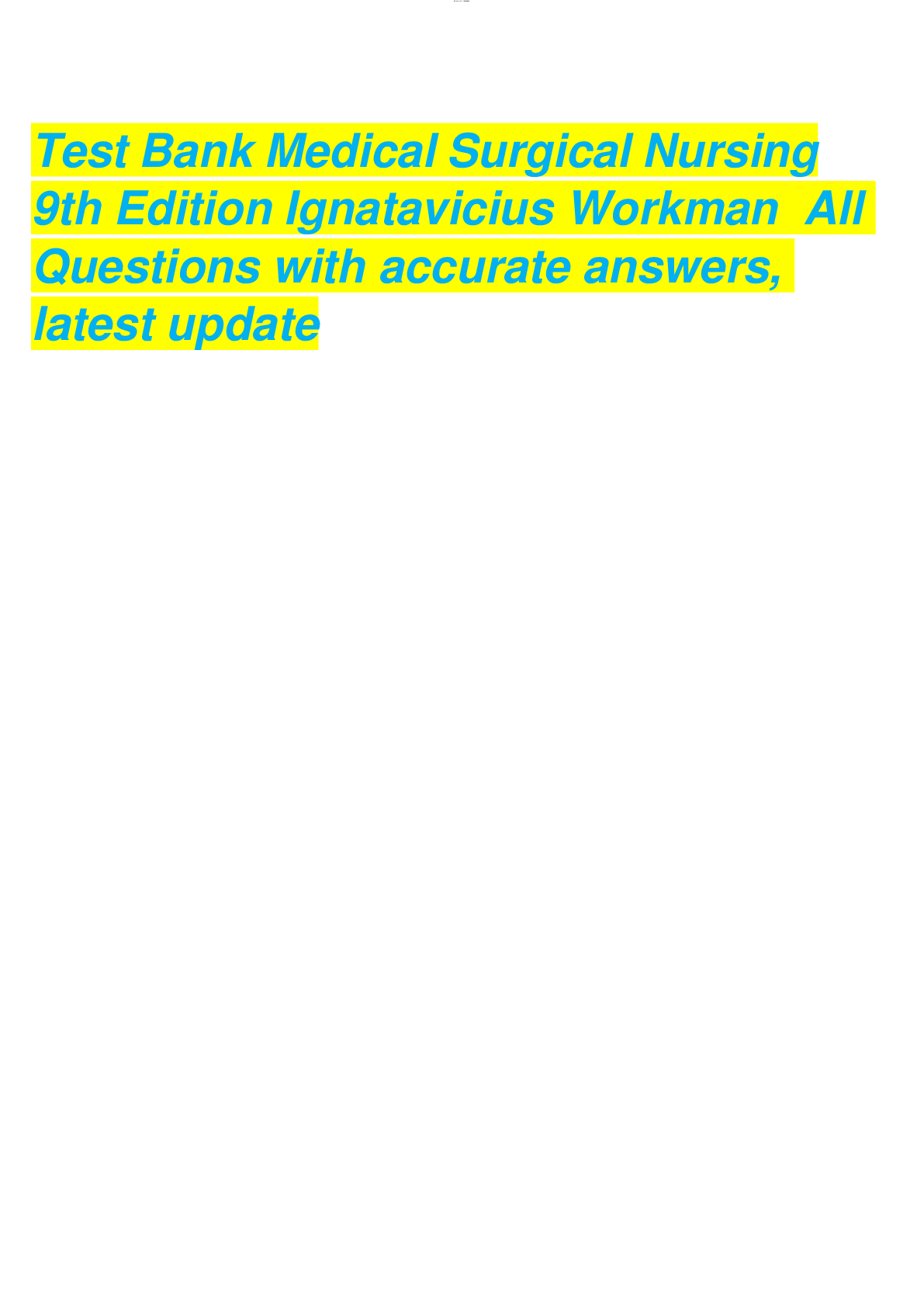
Reviews( 0 )
Document information
Connected school, study & course
About the document
Uploaded On
Oct 04, 2022
Number of pages
634
Written in
Additional information
This document has been written for:
Uploaded
Oct 04, 2022
Downloads
0
Views
115




